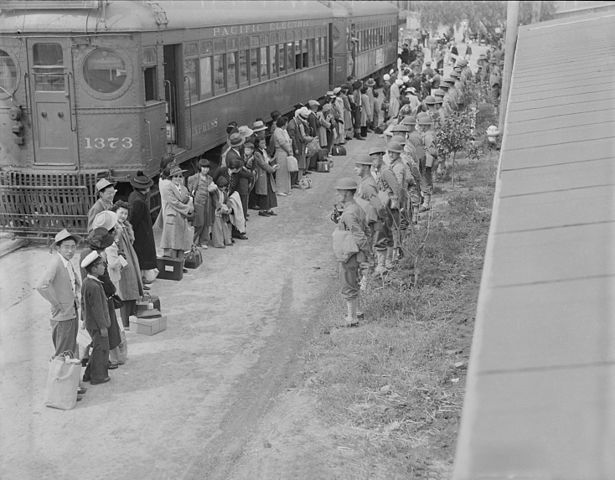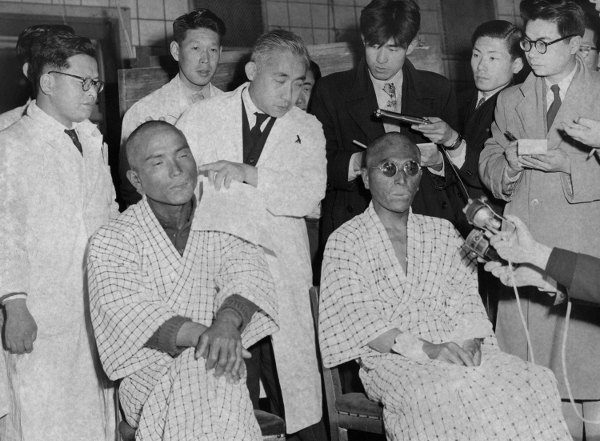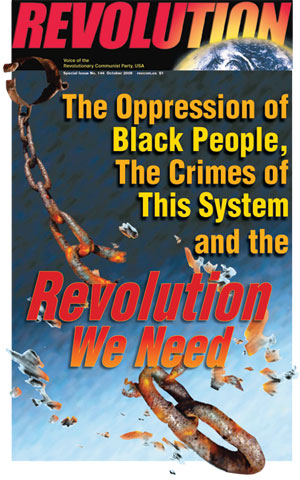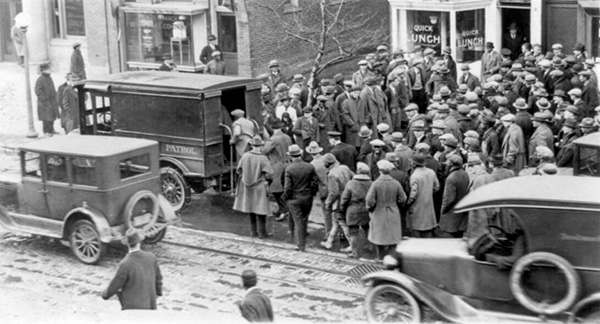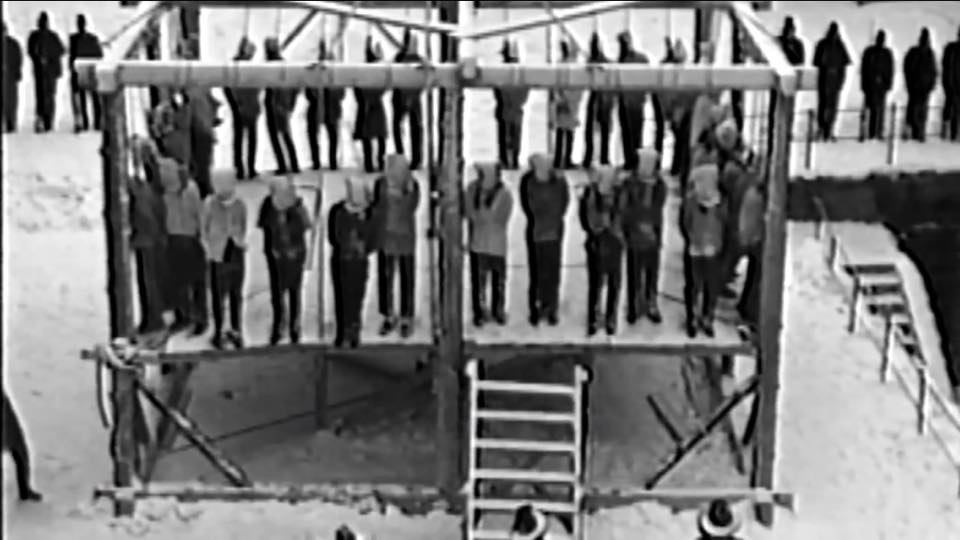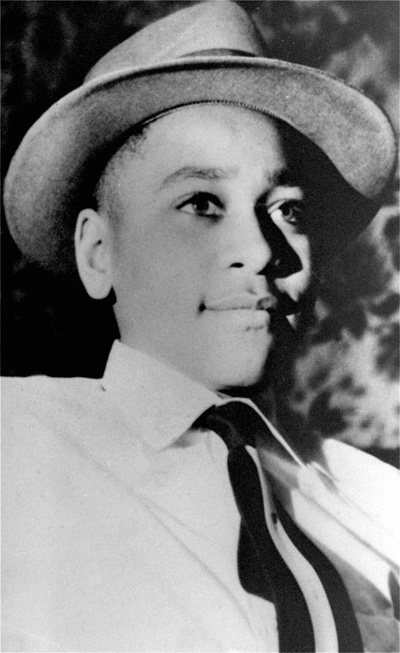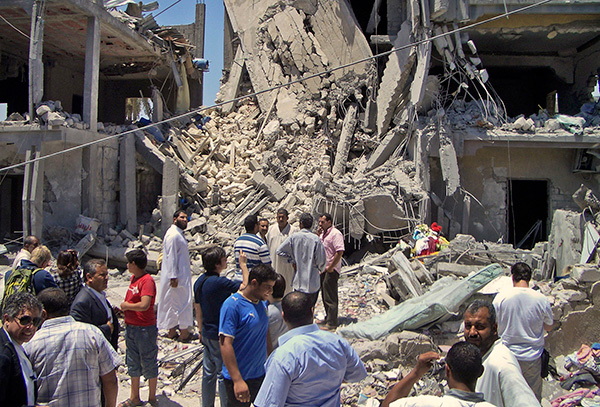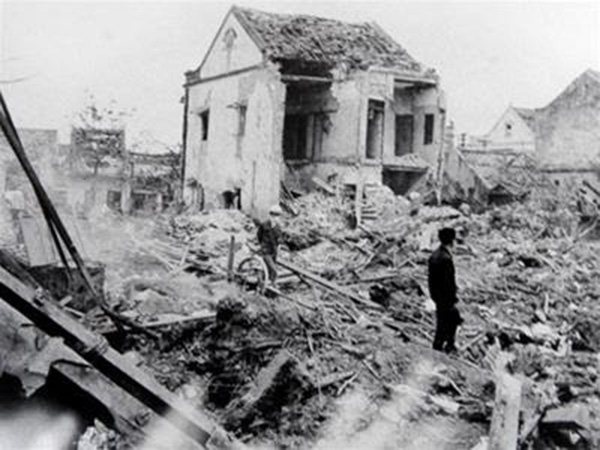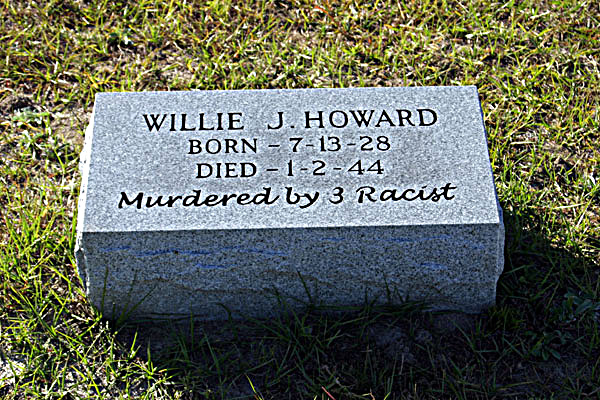| Revolution Newspaper | revcom.us
Clip: "Free Yourself from the GTF!"
Bob Avakian has written that one of three things that has "to happen in order for there to be real and lasting change for the better: People have to fully confront the actual history of this country and its role in the world up to today, and the terrible consequences of this." (See "3 Things that have to happen in order for there to be real and lasting change for the better.")
In that light, and in that spirit, "American Crime" is a regular feature of revcom.us. Each installment focuses on one of the 100 worst crimes committed by the U.S. rulers—out of countless bloody crimes they have carried out against people around the world, from the founding of the U.S. to the present day.
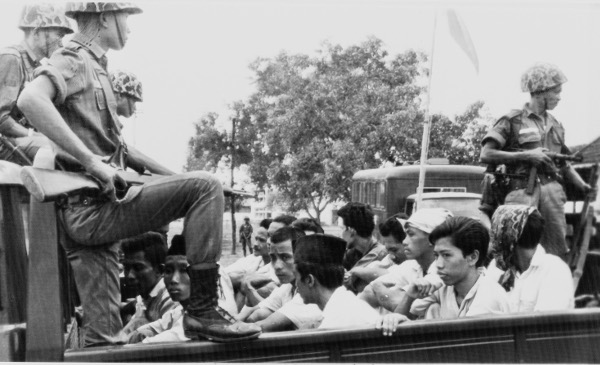 AP photo
AP photo
Case #100: 1965 Massacre in Indonesia
THE CRIME: Bloated corpses clogged and choked the rivers of Indonesia. Villagers didn’t want to eat anything caught in these waters because human fingers were found inside the fish. This sounds like a horror movie. But this was an American-made reality. For many months, starting at the end of 1965, the Suharto regime in Indonesia slaughtered people with wild abandon. At least 500,000, perhaps more than a million, people were killed, including members of the Communist Party of Indonesia (PKI), trade unionists, intellectuals, teachers, land reform advocates, ordinary peasants, ethnic Chinese, women, and children. Hundreds of thousands more were arrested and tortured. Read more
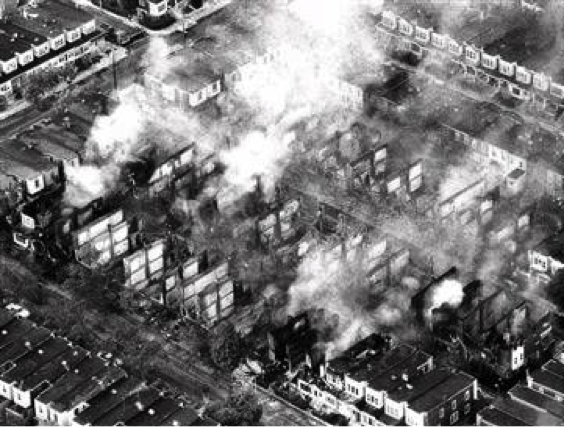
Case #99: May 13, 1985 – The MOVE Massacre
THE CRIME: 5:35 am, May 13, 1985. Philadelphia Police Commissioner Gregore Sambor aims his bullhorn at the house at 6221 Osage Avenue and declares: “Attention MOVE! This is America.” Seven adults and six children, members of the MOVE organization, were in their home. Outside, hundreds of heavily armed police and city officials surrounded them. Fifteen minutes later the police assault began. By the end, five children ages 9 to 14 were murdered by the police, as were six adults, their bodies mostly in pieces. Sixty-one homes were burned; 250 people rendered homeless. Read more
Case #98: 1953 CIA Coup in Iran: Torture and Repression – Made in the U.S.A.
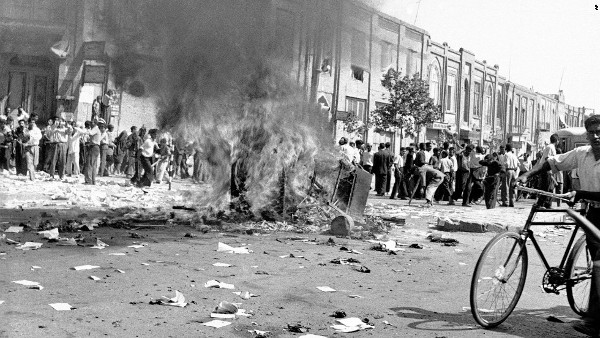
THE CRIME: On August 19, 1953, the U.S. Central Intelligence Agency (CIA) along with British intelligence launched a military coup overthrowing Iran’s popular, elected prime minister, Mohammad Mossadegh. In 1951, during an upsurge of protest against British colonialism, Mossadegh had nationalized Britain’s Anglo-Iranian Oil Company. Great Britain had plundered Iran’s oil wealth for decades. Britain moved to destabilize Mossadegh’s government, including by launching an international boycott of Iranian oil. The U.S. soon joined the coup plotting, conspiring with Iran’s Mohammad Reza Shah [King] Pahlavi and the military, and orchestrating an anti-Mossadegh propaganda campaign. Read more
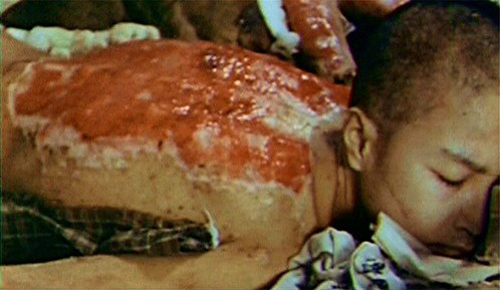
Case #97: August 6 and 9, 1945—The Nuclear Incineration of Hiroshima and Nagasaki
THE CRIME: At 8:15 am, on August 6, 1945, a blazing, million-degree fireball suddenly appeared just above the Japanese city of Hiroshima, instantly killing, burning alive, or vaporizing tens of thousands. Firestorms engulfed the city. Shockwaves and winds over 1,000 miles an hour came next, shattering bodies and buildings, hurling men, women, and children through the air. Nearly all structures were destroyed over a mile from ground zero. Read more
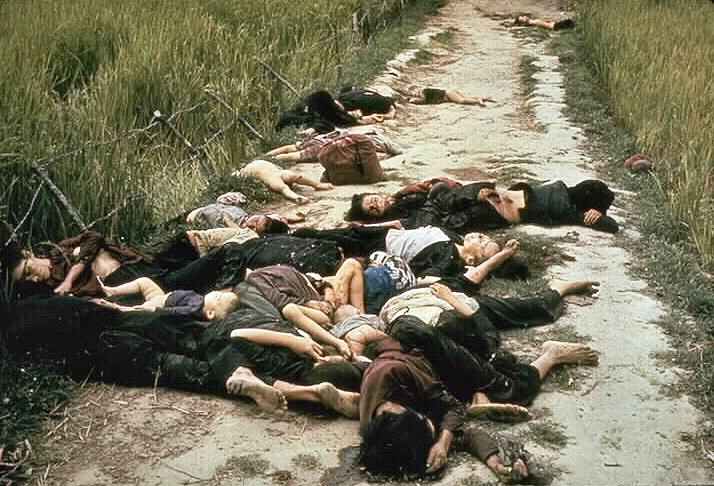
Photo: Wikimedia Commons
Case #96: Vietnam, March 16, 1968—The My Lai Massacre
THE CRIME: On Saturday morning, March 16, 1968, 100 soldiers from Charlie Company, U.S. Army Americal Division, entered and took over My Lai, a small hamlet in Vietnam’s countryside. “We met no resistance and I only saw three captured weapons... It was just like any other Vietnamese village—old papa-sans, women and kids,” a soldier said. “The order we were given was to kill and destroy everything that was in the village,” another soldier later testified. Read more

Photo: AP
Case #95: Reagan's Butcher Carries Out Genocide in Guatemala
THE CRIME: In the early 1980s, following a U.S.-backed coup by General José Efraín Ríos Montt, the Guatemalan military systematically destroyed more than 600 indigenous Mayan villages in the highlands of the country. Seventy-five thousand people, overwhelmingly Mayans, were slaughtered under Ríos Montt in this small, impoverished country in Central America. Soldiers ripped the hearts out of children as their bodies were still warm and piled them on a table for their parents to see. Read more
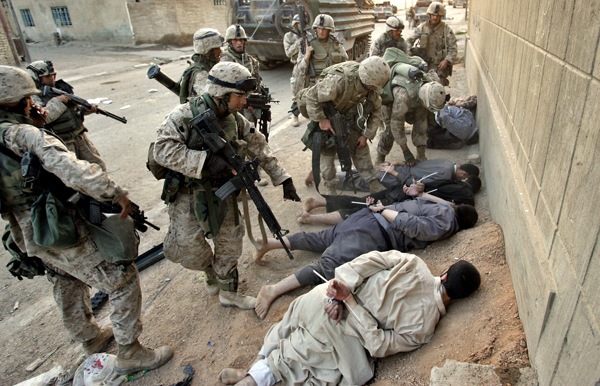
Photo: AP
Case #94: November 2004—War Crime Fallujah
THE CRIME: In the early morning hours of November 8, 2004, the U.S. launched “Operation Phantom Fury”—a massive air and ground assault on Fallujah, a city of 300,000 in central Iraq.
Weeks before, the U.S. military had cut off entry and exit from Fallujah. U.S. Marine and Army troops poured thousands of artillery rounds, hundreds of rockets, bombs, and missiles, and nearly 100,000 machine gun and cannon rounds into this densely populated city. A U.S. Marine sergeant warned, “We’ll unleash the dogs of hell, we’ll unleash ‘em... They don’t even know what’s coming—hell is coming! If there are civilians in there, they’re in the wrong place at the wrong time.” Read more
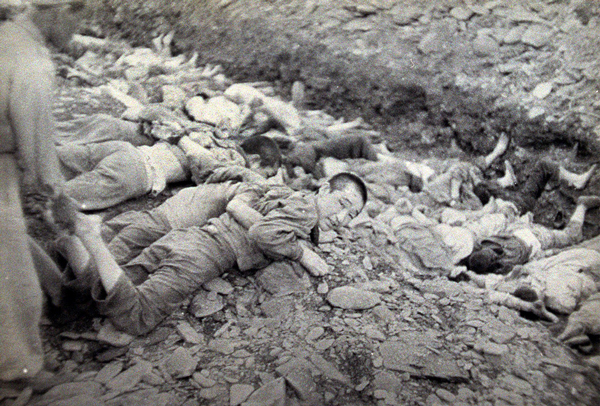 Photo: U.S. Army
Photo: U.S. Army
Case #93: U.S. Invasion of Korea—1950
The Crime: Mass murder of millions; carpet bombing an entire country into rubble; use of chemical weapons against civilians; repeatedly threatening use of nuclear weapons; wholesale rape of women.
In June 1950 the U.S. orchestrated a United Nations invasion of Korea. Of the 342,000 invading troops, 90 percent were American, and the entire force was under U.S. command. The U.S. and its allied war criminals killed millions of Koreans in three years of open warfare—estimates range from three to five million. The dead were overwhelmingly civilians. Read more
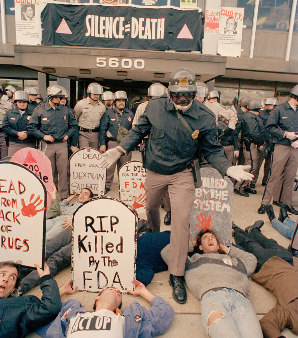
AP photo
Case #92: Ronald Reagan Condemns 180,000 Gay Men and Others to Demonization, and Death by AIDS
THE CRIME: In 1981, at the beginning of the Ronald Reagan presidency, an AIDS epidemic broke out in the United States. For four years, Reagan studiously refused to even utter the word “AIDS” in public. By 1987, the first time Reagan would address AIDS with any substance, the plague had killed over 180,000 people in the U.S.
The toll was excruciating. Friends and lovers saw each other stricken by (what at first was) a terrifyingly mysterious disease that left people wasted away, unable to eat, covered with cancerous sores and—in every case—dead. Read more
Case #91: School of the Americas—Training Ground for Mass Murderers and Torturers, 1946-Present
THE CRIME: Since 1946, the U.S. Army’s School of the Americas (SOA) has trained military officers from countries all over Latin America. The school’s curriculum includes sniper training, commando and psychological warfare, military intelligence, and interrogation tactics—including the use of torture, rape, disappearances, assassinations, and mass killings.

CIA and U.S. Army manuals used at the SOA have detailed torture techniques and advocated extortion, blackmail, and the targeting of civilian populations. A former political prisoner in Paraguay described how a section of these manuals gives “interrogators” instructions on “how to keep electric shock victims alive and responsive” and “recommends dousing the victims’ heads and bodies with salt water, and includes a sketch showing how this ‘treatment’ should be carried out.” Hundreds of thousands of people in Latin America have been tortured, raped, assassinated, “disappeared,” massacred, and forced to flee their homes and become refugees by armies and death squads led by military officers trained at the SOA. Read more
Case #90: The Sullivan Expedition, 1779—Genocide of Native Peoples and Scorched Earth in Upstate New York
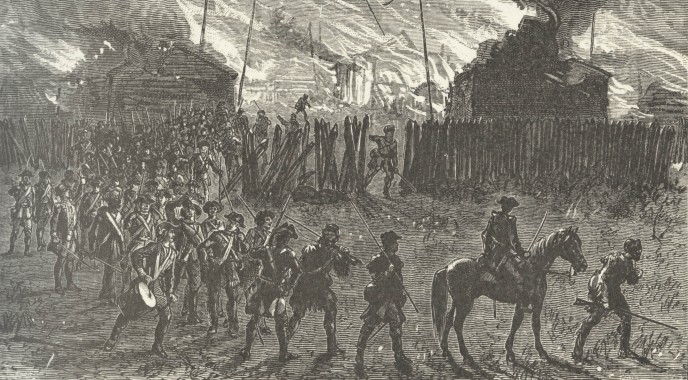
THE CRIME: In June 1779, heavily armed caravans of more than 6,200 American soldiers headed north from Pennsylvania and west from a town near Albany, New York. These forces, under the command of General John Sullivan, comprised about 25 percent of the Continental Army, which had been formed by the Continental Congress of former colonies that were in a war for independence from England.
Their target: Native American tribes who lived in western New York—the Mohawk, Oneida, Onondaga, Tuscarora, Cayuga, and Seneca peoples. These peoples called themselves the Haudenosaunee, and are known to historians as the Iroquois League or Iroquois Confederacy. The mission of Sullivan’s troops: the “total destruction and devastation of their settlements, and the capture of as many prisoners of every age and sex as possible,” in the words of the commander in chief of the Continental Army. Read more
Case #89: 120,000 People of Japanese Descent Put in U.S. Concentration Camps During World War 2
THE CRIME: During World War 2, 120,000 people of Japanese descent, nearly the entire Japanese population living in the continental U.S., were rounded up and imprisoned in concentration camps throughout the western states within months of Japan’s December 7, 1941 attack on Pearl Harbor, the U.S. naval base in Hawai‘i. Sixty-two percent of those imprisoned were U.S. citizens; and more than half were children. They were never charged with a crime; never given a hearing; but summarily rounded up and held for more than two years in remote locations, solely on the basis of their nationality. Read more
Case #88: Nuclear Testing in the Pacific
THE CRIME: Between 1946 and 1962, the U.S. government conducted nuclear tests in the Pacific Ocean, contaminating thousands of Pacific Islands. Entire peoples suffered and continue to suffer from the effects of this nuclear testing up to today.
In 1946, a year after the end of World War 2 and the nuclear bombing of Hiroshima and Nagasaki (see American Crime #97), the U.S. launched its first nuclear test on Bikini Atoll, in the Marshall Islands. Between 1947 and 1962 the U.S. conducted 102 atmospheric and underwater tests in the Pacific Proving Ground—comprising 80 percent of all nuclear contamination in the U.S. history of nuclear testing. This is roughly equivalent to 1.7 Hiroshima explosions every single day for the 12 years between 1946 and 1958. Of these tests, 67 were atomic bombs. Read more
Case #87: Operation Condor 1968-1980s
U.S.-Directed Campaign of Political Assassination and State Terror in Latin America
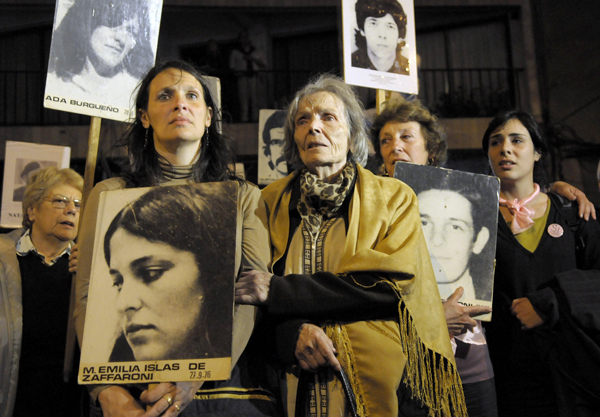 AP Photo
AP Photo
THE CRIME: From the late 1960s well into the 1980s, documents show that the U.S. secretly organized, financed, and directed a campaign of political repression, torture, disappearances, and assassinations code-named Operation Condor.
Starting in 1975, this multinational U.S.-led conspiracy was implemented by pro-U.S. right-wing military dictatorships in the Southern Cone of Latin America—Argentina, Chile, Uruguay, Paraguay, Bolivia, and Brazil (later joined by Ecuador and Peru). Operation Condor coordinated the intelligence operations between these countries; organized cross-border operations to detain and “disappear” dissidents and political opponents forced into exile; and, in its most secret “Phase III,” provided for the formation of special teams of assassins from member countries to travel anywhere in the world to carry out assassinations of “subversive enemies.” Read more
Case #86: 1964 Brazil Coup and Rise of Brutal Military Dictatorship
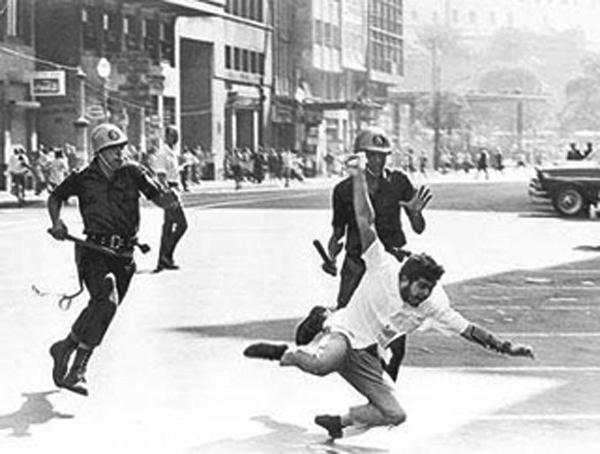
THE CRIME: In 1964, a section of the Brazilian military carried out a coup that overthrew Brazilian President João Goulart. The coup gave rise to two decades of a murderous and brutal military dictatorship and atrocities that led to the disappearance and death of close to 1,000 political opponents, and the systematic torture of over 30,000 more.
The coup had been anticipated—and worked for—by the U.S. for two years or more. And the U.S. provided supplies and funding for the coup. Just before the coup, the U.S. ambassador to Brazil received a secret telegram from Secretary of State Dean Rusk stating that the administration had decided to immediately mobilize a naval task force to take up position off the coast of Brazil including U.S. Navy tankers, along with an airlift of 110 tons of ammunition and other equipment including “CS agent”—a special gas used against street protests. President Lyndon Johnson was briefed on and signed off on that. Goulart was unable and unwilling to mobilize armed resistance, and within days of the coup he fled to neighboring Uruguay. The U.S. immediately recognized the new regime, and declared that the coup by the “democratic forces” had staved off the hand of international communism. Read more
Case #85: December 1984, Bhopal, India: Union Carbide’s Poison Gas Massacre
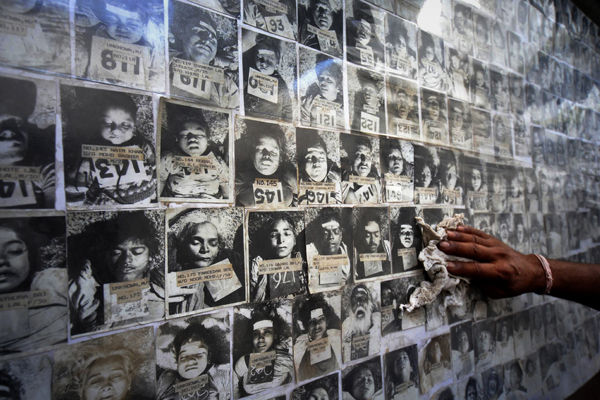
AP photo
THE CRIME: Shortly after midnight, early Monday morning on December 3, 1984, an explosion took place at the Bhopal, India, plant of the Union Carbide Corporation, a U.S.-based multinational. A tank containing methyl isocyanate (MIC), used to manufacture pesticides, exploded, blowing 40 tons of deadly chemicals into the air. Within moments, a poison cloud enveloped much of this city of 900,000.
In the densely-packed shanty settlements around the plant, thousands were awakened by the suffocating, burning effects of the gas, or by the howls of dying animals. The toxic cloud stayed close to the ground, so thick people were nearly blinded as they rushed to escape. Some vomited uncontrollably, violently seized, and fell dead. Gas spread over 40 square kilometers (15.4 square miles). Over 200,000 people were immediately impacted; half the city was driven from their homes. Read more
Case #84: Medical Racism and Homicide—the Tuskegee Syphilis “Study”
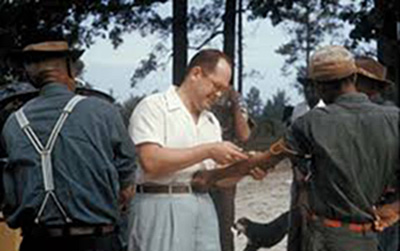
The Crime: Between 1932 and 1972, the U.S. Public Health Service (PHS) and the Centers for Disease Control studied the progression of untreated syphilis in a group of rural African-American men in Alabama under the guise of giving them free health care. According to the Centers for Disease Control, the men were told they were being treated for having “bad blood.”
A total of 600 African-American sharecroppers from Macon County, Alabama, were enrolled in the study. Of them, 399 had contracted syphilis before the study began, while the remaining 201 did not have the disease. These impoverished and often illiterate subjects were recruited with misleading promises of “special free treatment,” which were actually spinal taps done without anesthesia to study the neurological effects of syphilis, and they were enrolled without their informed consent (the men were never told the name of the study). Read more
Case #83: The U.S.-Mexico War of 1846-1848
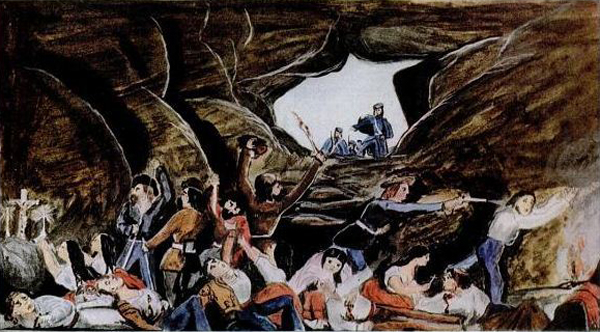
The Crime: In the spring of 1846, U.S. President James Polk sent General Zachary Taylor and several thousand U.S. troops into what had been—before slave-holding settlers from the U.S. declared it an independent "Republic of Texas" in 1836—Mexican territory between the Nueces and Rio Grande Rivers, near the Gulf of Mexico, with the goal of provoking a war. When Taylor's troops arrived at the Mexican town of Matamoros on the Rio Grande and began menacing maneuvers, they were attacked by a force of Mexicans, just as Polk and his cabinet believed they would be. President Polk wasted no time in declaring Mexico guilty of aggression against the U.S. Read more
Case #82: Murderous Neglect and Repression After Hurricane Katrina
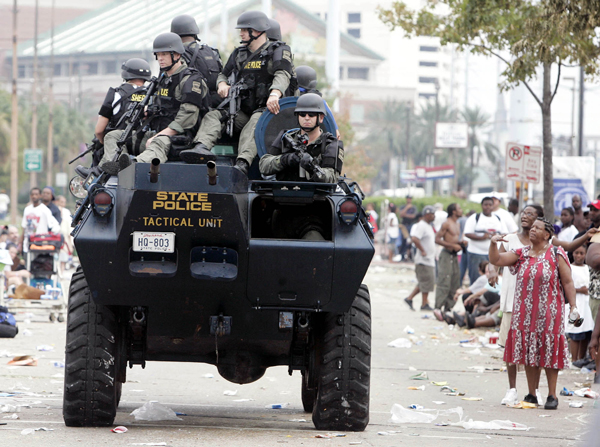
The Crime: On August 29, 2005, Hurricane Katrina hit the city of New Orleans, bringing terrible destruction. But the human suffering and death that followed was not, overwhelmingly, a result of the storm itself. It was a crime of this system.
Days before Katrina hit, meteorologists predicted a serious hurricane, saying the city, about half of which is between one and seven feet below sea level, should be evacuated. But the government did nothing to evacuate the city, stranding close to 100,000 people—people of all walks of life, but especially poor and Black people who did not have any means to leave.
The U.S. Army Corps of Engineers failed to ensure that the city’s levees could adequately hold in such a storm, and when they collapsed, floodwaters rose 20 feet in parts of New Orleans, and 80 percent of the city went under water. Neighborhoods below sea level, many of them poor and Black areas, were the most vulnerable to flooding. Nearly 2,000 died in the days after Hurricane Katrina hit, about 1,500 of them in New Orleans. Read more
Case #81: September 13, 1971—Massacre of Heroic Attica Prisoners
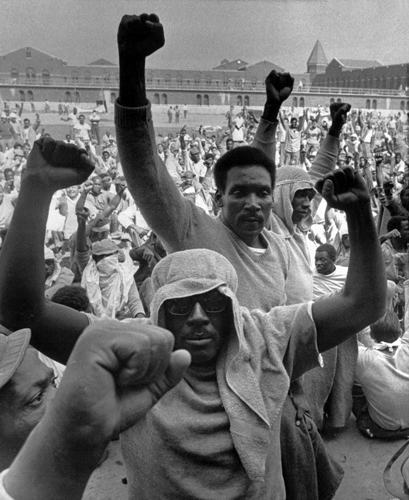
AP photo
The Crime: On September 13, 1971, police, sheriffs, park police, and the National Guard launched a murderous assault at Attica in upstate New York, killing 39 unarmed people.
Four days earlier, on September 9, the most powerful and significant prison rebellion in U.S. history had erupted at Attica. Over half of Attica’s 2,200 inmates, mainly Black but also white and Puerto Rican prisoners, seized control of large parts of the prison, taking 38 guards hostage.
The uprising was fueled by the guards’ routine abuse, horrific living conditions, the state’s refusal to address their grievances, and the racism and national oppression permeating Attica and U.S. society. Many Attica prisoners had been radicalized by the upheavals of the 1960s, and the August 21 murder of the revolutionary prisoner and leader George Jackson, by guards at California’s San Quentin prison, hit them very hard, sparking a silent fast in protest.
The spirit of the Attica Brothers, as they came to be called, was captured by their 21-year-old spokesman L.D. Barkley: “We are men. We are not beasts, and we do not intend to be beaten and driven as such... What has happened here is but the sound before the fury of those who are oppressed...” Read more
Case #80: 1915-1934: The U.S. Invasion, Occupation and Domination of Haiti
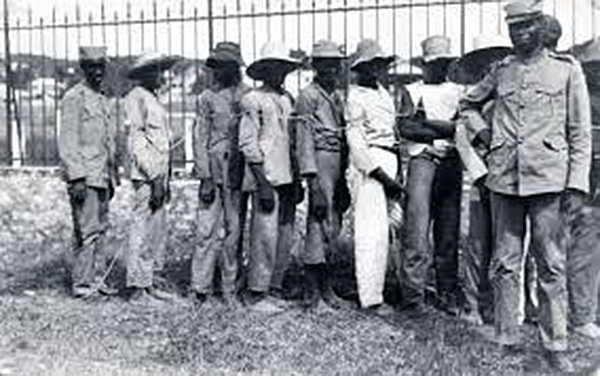
THE CRIME: On July 28, 1915, U.S. President Woodrow Wilson ordered 330 U.S. Marines to invade Haiti’s capital city of Port-au-Prince. This was the beginning of a 19-year U.S. occupation that didn’t end until 1934. At the time of the invasion the political situation in Haiti and the government itself were extremely unstable. U.S. troops landed after Haitian President Vilbrun Guillaume Sam was killed by people in the streets. And Sam himself had come to power after leading a revolt to topple the president a year earlier.
Haiti, a Caribbean country that shares the island of Hispaniola with the Dominican Republic, had been France’s most lucrative colony until the Haitian people rose up in the largest successful slave rebellion in history, led by Toussaint L'Ouverture in 1791. At the time of the U.S. invasion, Haiti was a poor, mainly rural country that different foreign imperialist powers were trying to dominate. Read more
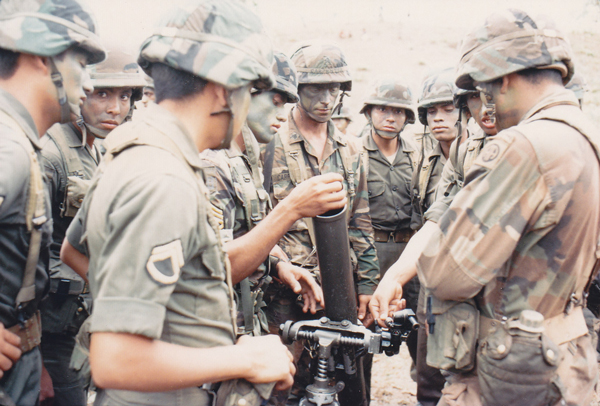
Case #79: Ronald Reagan’s Honduras—The Atrocities of “Battalion 316”
THE CRIME: The U.S. military and CIA trained, financed, and covered up the crimes of “Battalion 316”—a Honduran military death squad which carried out a campaign of torture, murder, and state-sponsored terror against the Honduran people during the 1980s. At least 184 Hondurans—including labor leaders, students, religious activists, and others the Honduran military considered political opponents—were stalked, kidnapped, brutally tortured, disappeared, and murdered by Battalion 316. Countless others were captured and tortured before ultimately being let go. Read more
Case #78: "Operation Wetback"—1954-56
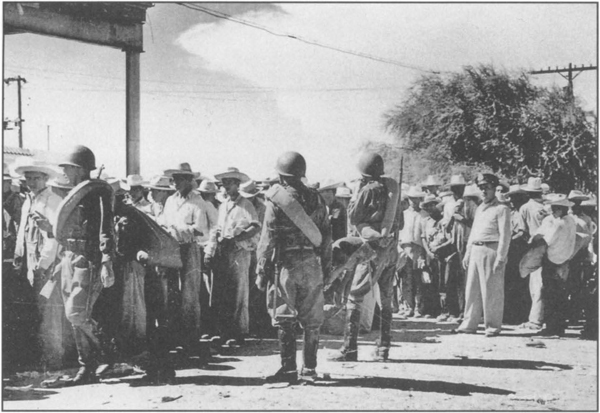
THE CRIME: Beginning in June 1954 and proceeding throughout that summer, the U.S. government carried out a military-style campaign of round-ups and deportations of Mexicans living in the United States. They called it “Operation Wetback,” after the openly racist term for Mexicans and Mexican immigrants—”wetback”—first invoked to slander immigrants who crossed the Rio Grande River.“Operation Wetback” drove 1.3 million immigrants from the U.S., tearing apart immigrant families and terrorizing and decimating entire communities, especially in California, Arizona, and Texas. It intensified racial divisions and stoked the fires of hatred against Mexicans and immigrants for years to come. Read more
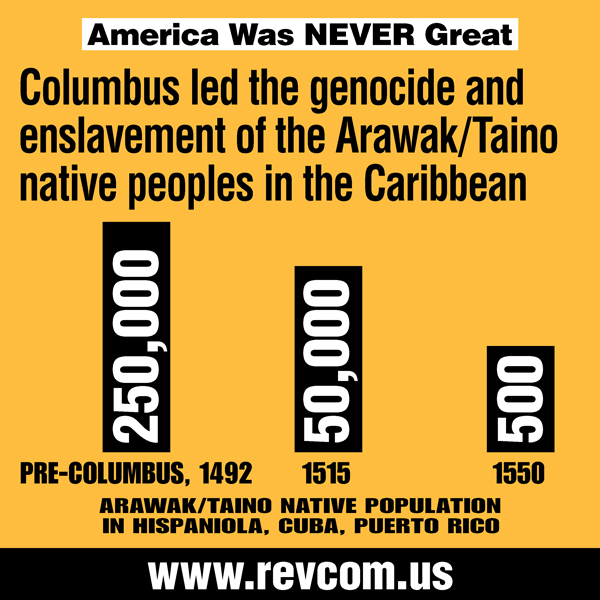
Case #77: Christopher Columbus Brought Genocide and Slavery to the "New World," and America Celebrates Him for It
THE CRIME: On October 12, 1492, Christopher Columbus, an Italian sailing for Spain, landed on what is now the Bermuda Islands. Columbus is celebrated in the U.S. as the person who first “discovered” the “New World,” making it possible for those who came after him, through hard work, to create the greatest global power in the world today, as the official declaration of “Columbus Day” as a national holiday states.
Columbus did not “discover” the Americas—they had been inhabited by many different indigenous peoples for some 13,000 years. But he did bring conquest and enslavement, and launched one of the most massive, horrific genocides in human history. Read more
Case #76: U.S.-UN Sanctions on Iraq—“A Legitimized Act of Mass Slaughter”
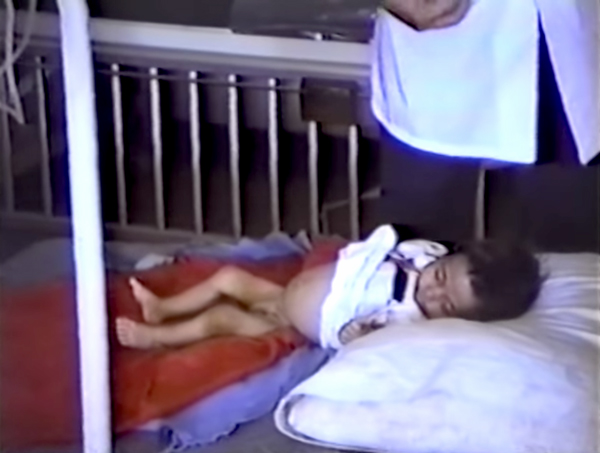
The Crime: From 1990 until 2003, the U.S. and the United Nations imposed crippling economic sanctions on Iraq, then ruled by Saddam Hussein. These sanctions began even before the U.S. destroyed much of Iraq’s infrastructure, including its electrical, water, and sewage treatment systems, during the January-March 1991 Persian Gulf War, and continued for more than a decade after the war ended. The results were catastrophic for millions of Iraqis, especially for the young, the sick, and the elderly.
Iraq depended on selling oil to buy needed imports of food and equipment for its industry and infrastructure. But U.S.-UN sanctions prevented this—both by preventing Iraq from selling enough oil and by blocking needed imports, often under the claim that they could be used by the military. Iraq’s economy was crippled, and it couldn’t fully repair its shattered electrical and water systems, or buy needed food and medicines. Even chemicals needed for treating water were being blocked. Read more
Case #75: Obama, Clinton and the 2009 Military Coup in Honduras
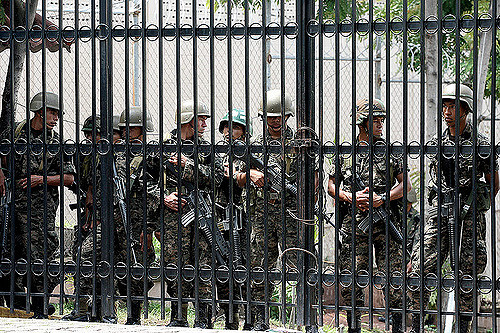
Photo: rbreve/flickr
THE CRIME: On June 28, 2009, the Honduran military carried out a coup d’etat against the elected president, Manuel Zelaya, a liberal-leaning populist. The coup had crucial backing from then-Secretary of State Hillary Clinton and the U.S. State Department. The generals and politicians behind the coup brought to power a more openly fascistic and pro-U.S. regime that plunged the Honduran people even more deeply into the hell of U.S. domination, state-sponsored political assassinations and terrorism, and intensified violence, poverty, and oppression. These horrors remain in effect to this day, with U.S. backing. Read more
Case #74: The FBI-Chicago Police Assassination of Fred Hampton
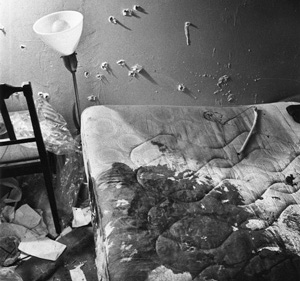
Photo: Paul Sequeiros
THE CRIME: At 4:45 am on December 4, 1969, a special operations team of 14 Chicago police stormed into the apartment of Fred Hampton, the 21-year-old chairman of the Illinois Black Panther Party. They were being directed by Cook County Prosecutor Edward Hanrahan and acting in close coordination with the FBI Counter Intelligence Program (COINTELPRO). Armed with shotguns, handguns, and a .45-caliber machine gun, and guided by a floor plan of the apartment provided by an informant, the police shot anyone they saw and sprayed the apartment with machine-gun fire.
Moving to the back of the apartment, they entered Fred Hampton’s bedroom. Hampton, already wounded, was still in bed, having been drugged earlier by the FBI’s informant. Alongside him was Deborah Johnson, his girlfriend who was eight-and-a-half months pregnant with their child. As they lay there, the cops stood over Hampton and put two bullets in his brain. One cop reportedly said, “He’s good and dead now.” Read more
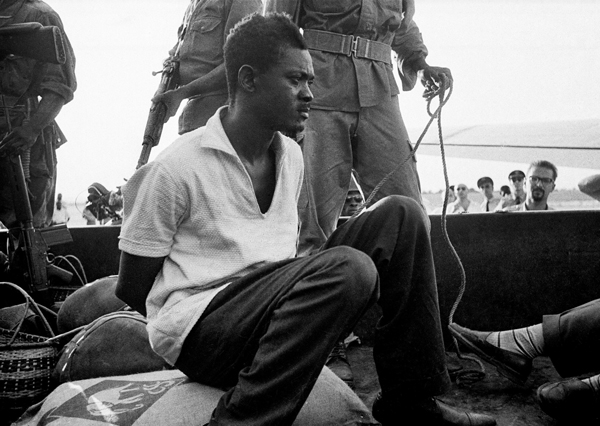
AP photo
Case #73: The CIA-Directed Murder of Patrice Lumumba
THE CRIME: On January 17, 1961, a firing squad shot to death the Congolese anti-colonialist fighter and leader Patrice Lumumba. His body was buried, but then dug up and dismembered with saws and axes. Then Lumumba’s body was burned and dissolved in acid so there would not even be a corpse around which his supporters could rally. This brutal murder was carried out by some of Lumumba’s Congolese enemies, but it was the U.S. imperialists who called for and orchestrated it. The Central Intelligence Agency (CIA) was in the forefront, aided by imperialist Belgium, which had ruled over and tormented the people of the Congo for the previous 75 years. Read more
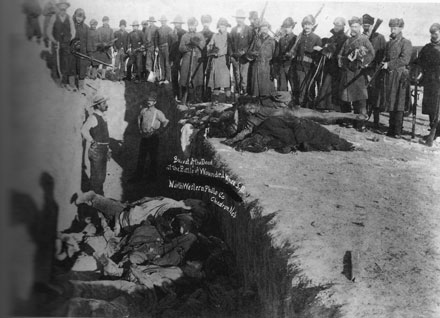
Photo: Library of Congress
Case #72: Wounded Knee Massacre, 1890
THE CRIME: On December 29, 1890, U.S. government soldiers massacred nearly 300 of the 350 Lakota men, women, and children on the Pine Ridge Indian Reservation in South Dakota. The massacre took place near Wounded Knee Creek. Some of the women murdered were already widows whose husbands had previously been killed by U.S. troops. The Lakota Chief Spotted Elk (Big Foot), who was dying of pneumonia, was among those massacred. Read more
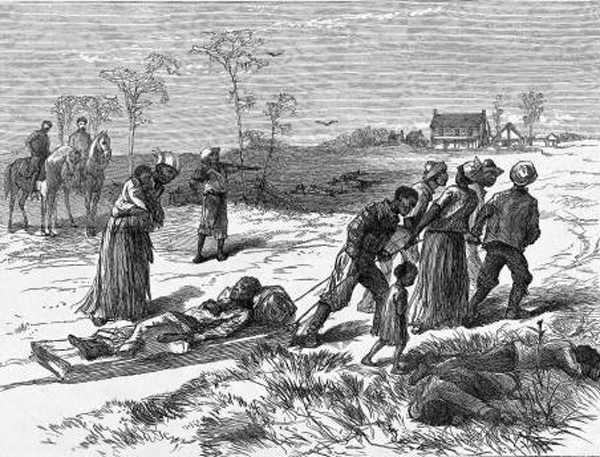
Case #71: The Colfax Massacre of 1873... and the Supreme Court Stamp of Approval for Racist Terror
On April 13, 1873, Easter Sunday, a mass slaughter of Black people occurred in Colfax, Louisiana. Over 300 heavily armed white men, most of them former officers and soldiers in the Confederate Army, shot, stabbed, burned, and maimed Black people seeking shelter in a courthouse. Many were killed as they tried to surrender. Historian Eric Foner described the Colfax massacre as the "bloodiest single instance of racial carnage in the Reconstruction era." Read more
Case #70: "Operation Iraqi Freedom," 2003
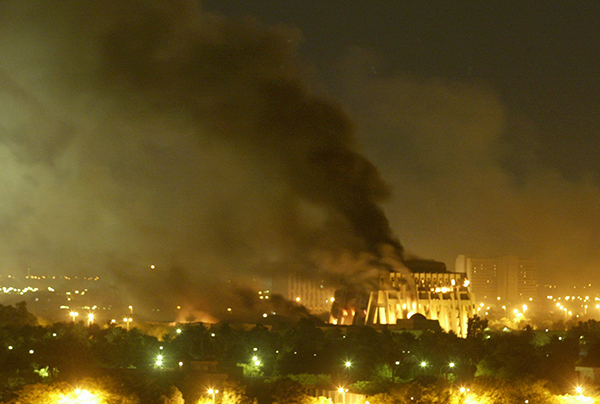
AP Photo
THE CRIME: At 10:15 pm on March 19, 2003, George W. Bush announced to the world: "At this hour, American and coalition forces are in the early stages of military operations to disarm Iraq, to free its people and to defend the world from grave danger."
As Bush spoke, U.S. bombs and missiles were raining on Iraq. Some 160,000 troops—overwhelmingly American—were poised to storm the country by land. Twenty-one days later, after a blitzkrieg-like invasion and some 27,000 bombs, the U.S. had seized control of Iraq's major cities. Baghdad, Iraq's capital, had fallen on April 9. Saddam Hussein's Ba'athist regime had been deposed and the U.S. took control of the country. On May 1, standing on the deck of the aircraft carrier U.S.S. Abraham Lincoln in front of a giant "Mission Accomplished" banner, Bush declared "major combat operations" were over. Read more
Case #69: Legalized Forced Sterilization in the U.S.
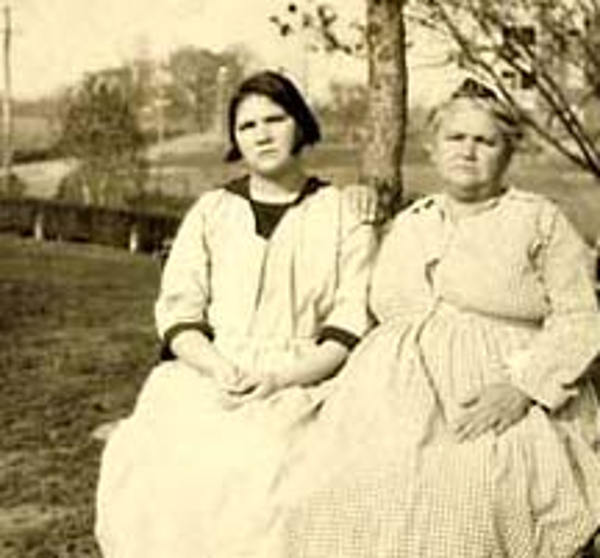
Carrie and Emma Buck
THE CRIME: On December 11, 1939, 18-year-old Andrea Garcia and her mother Sara appeared before Judge W. Turney Fox of the Los Angeles Superior Court for a hearing. Andrea’s probation officer, Karl Holton, had filed a petition to have her removed from her home and legally committed to a state institution. Judge Fox ruled that Andrea was indeed “a feeble-minded person” and from an “unfit home.” By the end of the week Andrea was committed to the Pacific Colony “Home for the Feeble-Minded” in Pomona, California—and a request was made by the superintendent to have her sterilized.
Sara strongly disagreed with both the commitment and the sterilization of her daughter. Within a week, with legal assistance from attorney David C. Marcus, Sara filed for a writ of prohibition against the sterilization of her eldest daughter, indicating that this procedure would be “performed ... upon the body and person of said minor child,” “against [their] wishes and desires,” and “without their permission or consent,” and there would be no remedy thus causing “great and irreparable damage.” Read more
Case #68: The 1965 U.S. Invasion of the Dominican Republic
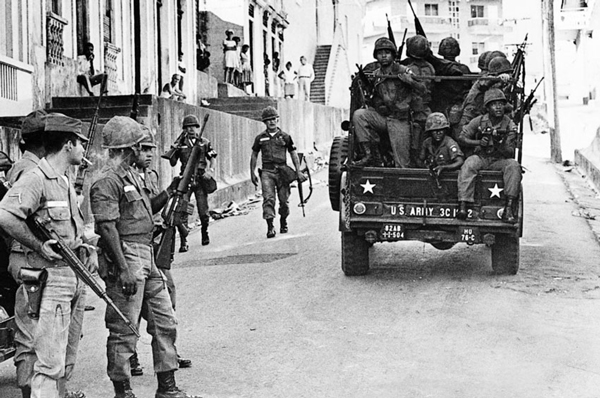
THE CRIME: On April 28, 1965, the U.S. sent its Marines to invade the Dominican Republic in an assault they dubbed “Operation Power Pack.” Within 10 days, the U.S. landed over 22,000 troops made up of Marines and the elite counter insurgency 82nd Airborne unit, Special Forces, psychological operations units, and a fleet of 41 vessels to blockade the island. Ultimately, 40,000 U.S. troops took part in this military onslaught. The U.S. also cobbled together another 2,000 to 3,000 troops from their Latin American allies, which they dubbed the “Inter-American Peace Force.”
The objective of the 1965 U.S. invasion was to brutally crush the mass armed rebellion that arose on April 24, 1965 in the Dominican Republic. Read more
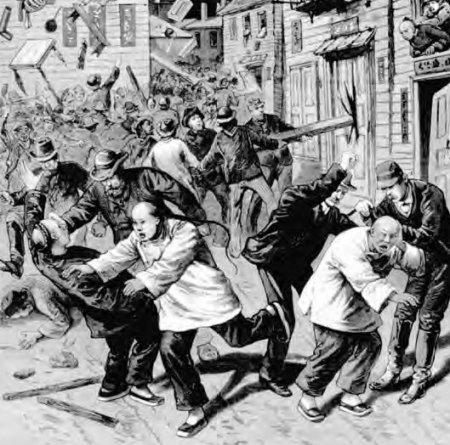
Case #67 - 1848-1900: Brutal Exploitation and Ruthless Oppression of Chinese Immigrants
THE CRIME: Between 1850 and 1900, Chinese immigrants were super-exploited in the mines, fields, and railways, and were subjected to savage discrimination and repression, including lynch-mob pogroms.
Beginning in 1848, immediately after invading and seizing over half of Mexico’s land, including the entire state of California, American capitalists began to lure Chinese immigrants to fill their huge thirst for cheap labor for their westward expansion into the California gold rush and to build transcontinental railroad. These (nearly all male) immigrants were worked like pack animals in horrific conditions from dusk to dawn, crammed into tiny tents, fed and slept on wooden cots, and in extreme weather. In one incident, when the workers went on strike, the company cut off all food supplies to the remote work camps and starved them for a week. Read more
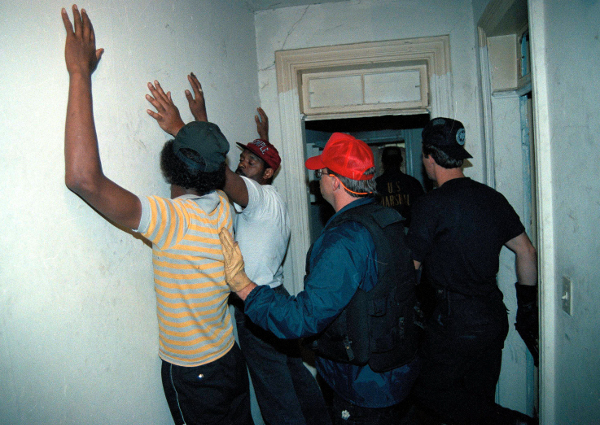
Case #66: The “War on Drugs,” 1970 to Today
The Crime: The “War on Drugs” was first called for in 1971 by then President Nixon, launched in earnest by President Ronald Reagan in 1982, and stepped up or continued by every U.S. president since. This “war” has been justified in the name of combating “rising crime,” protecting people from “drug lords” and “drug gangs,” and/or ending the “scourge” of drugs and drug addiction.
In 1982, Reagan officially launched this “war,” and made it a central focus of his administration (1981-89). Police, DEA, and other law enforcement budgets soared. Between 1981-91, for example, the DEA budget soared from $86 million to $1,026 million, while the FBI’s rose from $38 million to $181 million. Meanwhile, budgets for drug treatment, education and prevention were drastically reduced. Read more
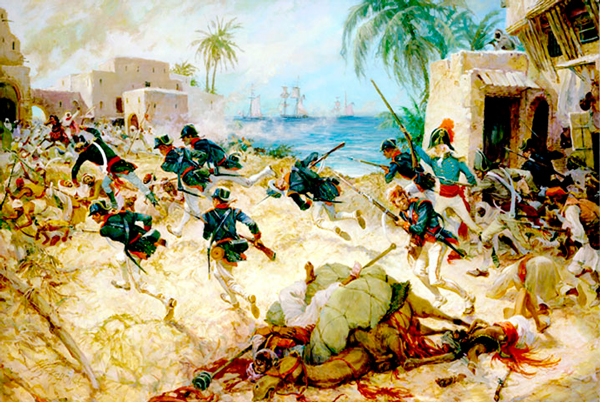
“Attack on Derna” by Charles Waterhouse
Case #65: The First Barbary War, 1801-1805
THE CRIME: In 1801, President Thomas Jefferson dispatched the Navy and Marines to blockade and then invade Tripoli (then part of the Ottoman empire, now known as Libya), launching the First Barbary War that culminated in 1805 in the brutal Battle of Derne. Jefferson did so in the name of combating “piracy” and “free commerce,” after Tripoli’s Muslim ruler, Yusuf Karamanli, renounced his 1797 treaty with the U.S. and demanded a lump-sum payment of $225,000 plus $20,000 each year for allowing U.S. ships to transit waters off the coast and deliver and pick up cargo at Tripoli’s port.
Jefferson declared America’s response to Tripoli’s ruler was “sent by squadron,” dispatching war ships to the Northern coast of Africa to blockade the port of Tripoli, where naval battles between U.S. and Tripolitan ships ensued. In 1803, after the U.S. frigate Philadelphia ran aground while chasing a Tripolitan ship and the crew of 307 was taken hostage, Jefferson sent five frigates, including the USS Constitution along with the Marines to “subdue, seize and make prize of all vessels, goods, and effects” in Tripoli. Read more
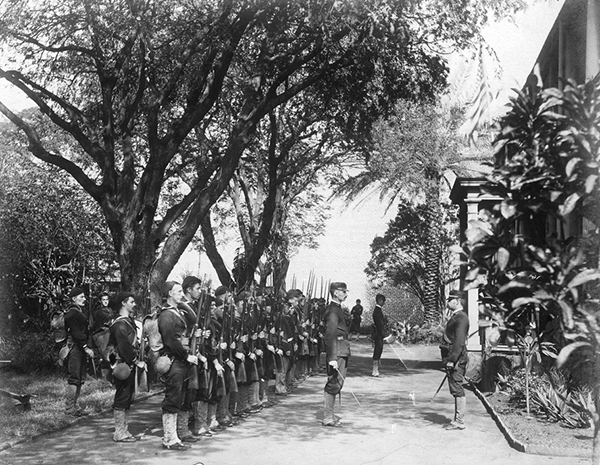
Marines marched from the USS Boston to I'olani Palace as part of taking over the Hawai’ian government.
Case #64: The U.S. Conquest of Hawai`i
THE CRIME:
The Overthrow: On January 17, 1893, 162 armed U.S. sailors and Marines marched from the USS Boston, harbored in Honolulu Harbor, to Iolani Palace, the center of Hawai’i’s government, and set up camp. This act of war against a nation struggling for independence from foreign domination put the U.S. firmly in control.
Lorrin Thurston, the grandson of an American missionary who had the support of Hawai`i’s white business class, had organized a coup d’etat. And the U.S. had agreed to provide military back up. Thurston’s core conspiracy group, which included Hawai`i’s powerful sugar barons, joined the “Honolulu Rifles” a heavily armed militia of 1,500 largely white businessmen, who patrolled the streets to put down any Native Hawaiians who might rebel. Read more

Case #63: April 20, 2010, BP Deepwater Horizon Gulf Oil Disaster
THE CRIME: On April 20, 2010, some 50 miles off the Louisiana coast, methane gas burst from the Macondo well being drilled a mile under the surface of the Gulf of Mexico by the global oil giant BP. The gas surged up the piping into the Deepwater Horizon drilling platform and exploded, creating an inferno of flame and smoke. Eleven of the rig’s 126 workers were killed and 17 more injured. The platform was destroyed, the well’s piping ripped apart, and a toxic gusher let loose from the sea floor. It poured 210 million gallons of crude oil into the waters of the gulf before it was capped 87 days later. Satellite images showed the spill impacted 68,000 square miles of ocean—roughly the size of Oklahoma. Oil washed up on shores and into estuaries and wetlands in Florida, Alabama, Mississippi, Louisiana, and Texas.
The BP oil disaster was the largest marine oil spill in history, and perhaps the U.S.’s worst environmental catastrophe ever. Read more

April 1941. Apartments in Chicago’s segregated South Side, known as the “black belt.” Photographer: Russell Lee/Library of Congress
Case #62: How Capitalism + White Supremacy Created Chicago’s Black Ghetto
Part 1: Great Migration and the Brutal Reality of the “Promised Land”
THE CRIME: For decades in the 20th century, the deliberate policies of the U.S. government and actions of the courts, local political and law enforcement forces, racists white residents, and—driving it all forward—predatory real estate interests and blood-sucking banks and other financial institutions forced millions of Black people in Chicago into confinement in ghettos under extremely oppressive living conditions. This played a key role in cementing in place a system of white supremacy that has super-exploited and suppressed the African American people since the Great Migration not only to the North but to cities more generally, beginning in the 20th century.
Part 1 of this two-part American Crime installment covers the period up to the 1960s.
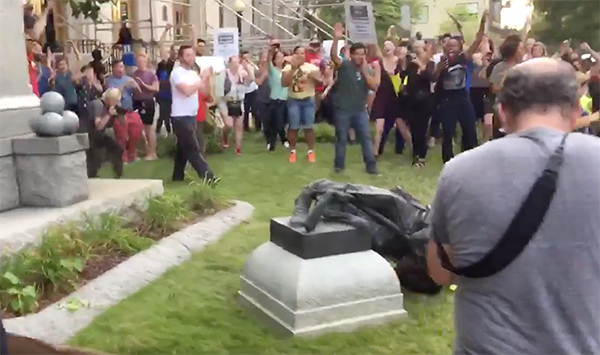
August 14, 2017. A Confederate statue is pulled down in Durham, NC. Credit: twitter/@DerrickQLewis
Case #61: Monuments to the Confederacy Across the United States
THE CRIME: Today there are over 1,500 monuments, statues, buildings, roads, schools, parks, and military bases across the U.S. honoring the leaders, generals, and soldiers of the Confederate states that waged the Civil War (1861-65) to defend slavery.
The biggest wave of Confederate monument construction took place from 1890 to 1920, after Reconstruction was ended. Hundreds of monuments and statues were built, at least 189 of them on courthouse grounds, and almost all of them in the South. A smaller construction spike took place from the mid-1950s to the late 1960s, when over 45 were dedicated or rededicated nationally. Read more

African-American soldiers of the 24th Infantry at Camp Logan, Houston, Texas in 1917. Credit: YouTube
Case #60: The 1917 Camp Logan Rebellion and the Mass Legal Lynching of 19 Black Soldiers
THE CRIME: December 11, 1917: At five in the morning, 13 Black soldiers are taken from the barracks at a military camp near San Antonio, Texas, and marched to the gallows. Each is placed on a chair, noose slipped over his head. Simultaneously, the chairs are kicked out and the soldiers drop to their death. Buried in graves nearby, the markers are not their names, just numbers 1 through 13. Each, to the end, proclaimed his innocence.
The court martial of 64 members of the all-Black 24th Infantry was the largest murder trial in U.S. history. Read more
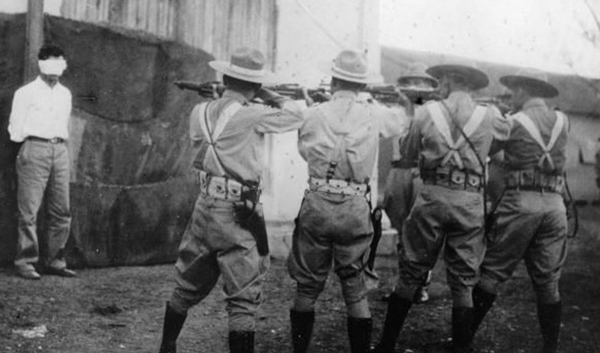
With U.S. help, Fulgencio Batista became the new head of the Cuban military and assumed the role of a U.S. strongman, ruling Cuba from 1940 until the revolution in 1959. Batista relied on repression, racism, torture and public executions, shown here, to stay in power.
Case #59: The U.S. Invasion, Occupation, Domination, and Plunder of Cuba: 1898 to 1959
THE CRIME: The seizure of Cuba (and other Spanish colonies—Puerto Rico, Guam, and the Philippines) in the Spanish-American War in order to gorge on the exploited wealth but also to prevent rivals from moving in. The U.S. was very explicit about this. The Platt Amendment specifically prohibited any power, other than the U.S., from establishing bases on Cuba. The U.S. also feared that the revolutionaries in Cuba—hundreds of thousands of poor working people, small farmers, the majority of them Black people who had been slaves until the 1880s, and some middle class professionals, and members of the Cuban elite—would defeat Spain and set up an independent country that would be unfavorable to U.S. interests.
The invasion of Cuba and other Spanish territories at the end of the 19th century signaled the emergence of the United States as an imperialist world power. Its successful invasion, domination, and plunder of Cuba was but a glimpse of the immense crimes to come. Read more.
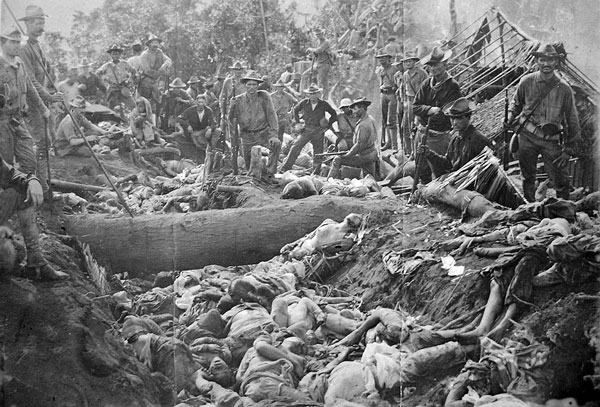
The bodies of Moro insurgents and civilians killed by U.S. troops during the Battle of Bud Dajo in the Philippines, March 7, 1906.
Case #58: U.S. Conquest of the Philippines 1899-1902
THE CRIME: In April 1898, the United States declared war against Spain, launching the Spanish-American war. In August, Spain, facing defeat, allowed U.S. forces to take control of Manila. By the end of 1898, Spain was forced to cede its colonies of Cuba, Guam and Puerto Rico to the U.S., and for $20 million, the Philippines.
In early 1899, when it became clear the U.S. had no intention of allowing the Philippines to be independent, Emilio Aguinaldo, who led the Filipino people’s revolt against the Spanish colonialists, launched a new war of independence against the U.S. imperialists. The U.S. war on and occupation of the Philippines lasted from 1899 to 1902. Over 126,000 U.S. troops were sent to crush the Filipino people’s mass uprising, and they waged war on wide swaths of the Philippine population as a whole. According to one account: “it became commonplace for entire villages to be burned and whole populations to be imprisoned in concentration camps. No mercy was accorded to Filipino prisoner, a large number of whom were shot.” Read more.
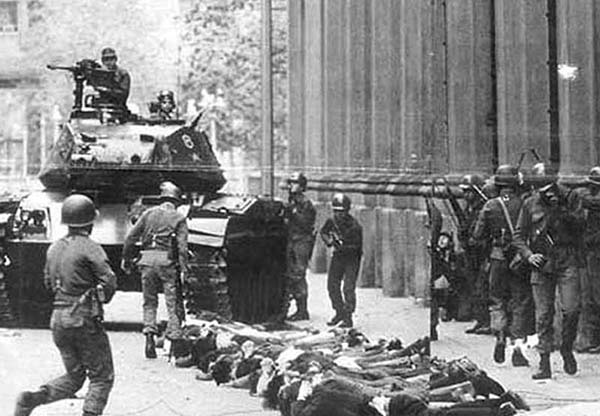
In the weeks that followed the coup, tens of thousands of officials of Allende’s government and the Unidad Popular governing coalition, along with workers, union leaders, activists, students, progressive intellectuals, artists and people who just happened to be on the streets on the morning of September 11, were rounded up and emprisoned in institutions and concentration camps.
Case #57: The 1973 CIA Coup In Chile
THE CRIME: Beginning in the early morning hours of September 11, 1973, the Chilean military, with political guidance and secret backing from the U.S., carried out a military coup against the government of Chilean president Salvador Allende. With U.S. Navy ships offshore and U.S. spy planes overhead as backup, the Chilean Air Force and tanks and soldiers from the Chilean Army dropped bombs and launched artillery and small-arms fire in a furious, coordinated assault on La Moneda palace, the central government building in Chile’s capital, Santiago. Allende, a social democrat elected on a platform of social reform three years previously, was killed along with a small group of defenders.
The CIA had collected “arrest lists” and “key government installations which need to be taken over,” according to a 1975 U.S. Senate investigation. In the hours, days and weeks that followed the coup, tens of thousands of officials of Allende’s government and the Unidad Popular governing coalition, along with workers, union leaders, activists, students, progressive intellectuals, artists and people who just happened to be on the streets on the morning of September 11, were rounded up, then held in Santiago’s National and Chile stadiums and in military installations and facilities converted to concentration camps in locations around the country. They were subjected to brutal physical and psychological torture, or just outright murdered. Read more.
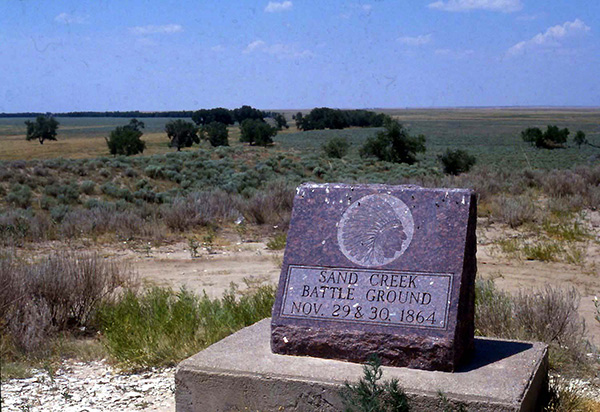
The site of the Sand Creek Massacre. Photo: Wikimedia Commons
Case #56: The 1864 Sand Creek Massacre
THE CRIME: They came at dawn, November 29, 1864, 700 heavily armed soldiers of the 3rd Colorado Cavalry, led by Colonel John Chivington. They rode rapidly toward their target, a Cheyenne village near Sand Creek, where the people were caught by surprise because months earlier, representatives of the U.S. government had met with their chief, encouraged him to settle near the creek, and had promised him and his people peace and safety. As the soldiers approached, the chief, Black Kettle, raced to raise the American flag over his lodge in a show of solidarity; others raised white flags of surrender. It didn’t matter.
The soldiers opened fire with carbines and cannons, killing at least 130, almost two-thirds women, children, and the elderly. Most of the young men were out hunting when the attack occurred; otherwise, the death toll would have been considerably higher. Before leaving, the soldiers burned the village and mutilated the dead. Read more.
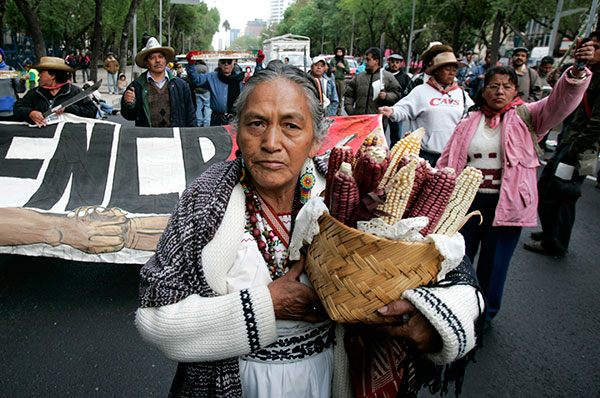
Mexican farmers protest the end of import protections implemented under NAFTA for their country's corn and bean crops. Mexico City, 2008.
Case # 55: The 1994 North American Free Trade Agreement—NAFTA (Part 1)
THE CRIME: A “free trade” agreement between the U.S., Canada, and Mexico, known as NAFTA (North American Free Trade Agreement), was implemented in 1994 with much fanfare. The secretly negotiated 2,000-page treaty was touted as a measure to bring increased prosperity to the people of the three countries. In fact, NAFTA was a predatory treaty whose effect was to ratchet up the cruel and reckless plunder of Mexico and its people.
Under NAFTA, maquiladora factory “sweatshops” along the U.S.-Mexico border expanded dramatically. Within a short time after NAFTA’s ratification, more than 1,000 maquila factories employed a million workers, 75 percent of them women, in oppressive conditions producing cheap goods for U.S. manufacturers at a fraction of the wages paid to U.S. workers.
But the most damaging effects of NAFTA in Mexico lay in the changes it brought to Mexico’s countryside. There it inflicted vulture-like destruction to millions of small and medium peasant farmers, especially its corn farmers. Read more.
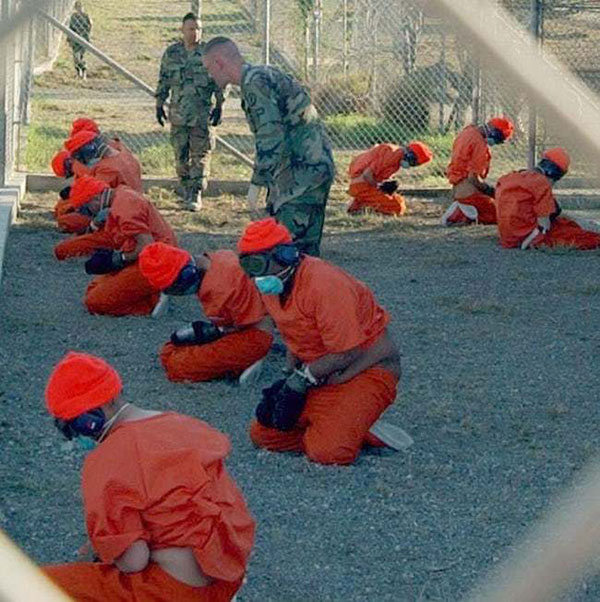
Case #54: The Guantánamo Torture Chamber
THE CRIME: In January 2002, in the wake of the attacks of September 11, 2001, George W. Bush’s administration established the Guantánamo Bay Detention Camp on the Guantánamo Naval Base in Cuba. For the last 15 years and continuing today, Guantánamo has functioned as a torture center, where hundreds have been sent after having been illegally detained, held indefinitely, and tortured.
Soon hundreds of men around the world, anyone the U.S. or its allies suspected as a target of its “war on terror” as well as many others, were seized and detained in this prison indefinitely for years, without trials or even charges, hearings or access to the legal system in most cases. This was a war crime in clear violation of the Geneva Conventions and international law. At Guantánamo and elsewhere, the U.S. legally justified and created new “enhanced interrogation techniques” (commonly considered by most of the international community to be torture). Read more.
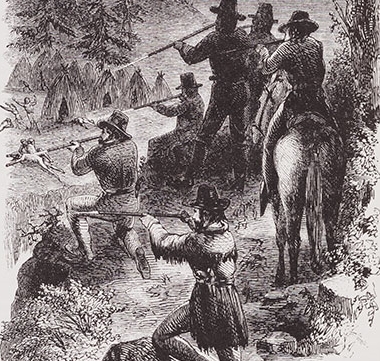
Case #53: The Genocide of California's Native Americans, 1846–1873
THE CRIME: From 1846 to 1873, a mass genocide was carried out against California’s Native American population by the U.S. government and white settlers. In 1846, before the 1848 Gold Rush, 157,000 people were living in California, 150,000 of them Native Americans. It was the densest and most diverse Native American population in the U.S. By 1873, there were only 30,000 Native Americans left alive, and by 1880, only 16,277.
This massive ethnic cleansing was the result of the genocidal murders of the native population at the hands of U.S. soldiers, volunteer state militiamen, and vigilantes. This included large massacres that wiped out entire villages, group killings, individual killings, the starvation of thousands, and the death of thousands due to diseases while imprisoned in U.S. Army forts or on federal Indian reservations. Read more.

By 1998 there were more than a million workers in 3,700 factories assembling electronics, clothing, toys, auto parts, and other products for sale in the U.S. As many as 75% of those hired in the maquiladoras were women, the majority 16 to 23 years old.
Case # 52: NAFTA (Part 2):
Deepening the Plunder and Domination of Mexico and the Exploitation and Oppression of Mexican Workers, Especially Women
The Crime: The “free trade” agreement between the U.S., Canada, and Mexico, known as NAFTA (North American Free Trade Agreement), was implemented in 1994 with much fanfare. The secretly negotiated 2,000-page treaty was touted as a measure to bring increased prosperity to the people of the three countries. NAFTA was, in fact, a predatory treaty whose effect was to ratchet up the cruel and reckless plunder of Mexico and its people. This mainly occurred through the rapid expansion of low-wage border “sweatshops” called maquiladoras. U.S. businesses have reaped enormous profits from hundreds of thousands of low-wage Mexican workers.
As many as 75 percent of those hired in the maquiladoras were women, the majority between the ages of 16 and 23. Many were recent arrivals from rural villages and towns. The factory owners hired young women for their dexterity and youthful energy. But they were also preferred because, in societies (on both sides of the border) dominated by patriarchy and misogyny, women are more exploitable—could be put to work for long, exhausting hours, often with no breaks and very short lunch periods with pay lower than their male counterparts. As women, they are regarded as “supplementary income-earners.” Read more.
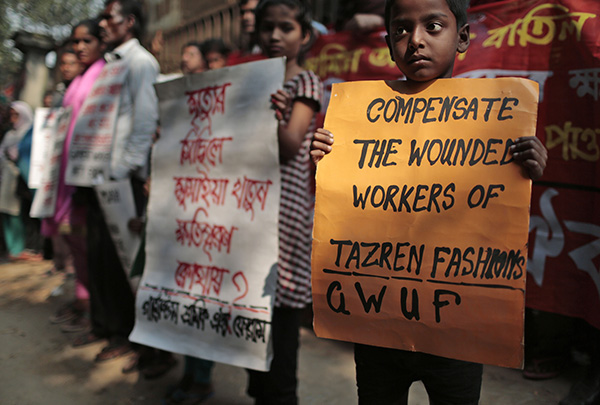
Children of Tazreen Fashion workers who died in the Bangladesh garment factory fire, November 2014. Photo: AP
Case # 51: Tazreen Bangladesh Garment Inferno
THE CRIME: During the early morning hours of November 24, 2012, 600 of the more than 1,400 daily workers at the nine-story Tazreen Fashions factory near the Bangladesh capital of Dhaka stayed on to work overtime producing ready-made garments (RMG) for Walmart, Sears, Walt Disney Co., and other major transnational retailers.
A fire, apparently starting near electric generators on the ground floor in an area of the factory used illegally as a warehouse, rapidly spread upward throughout the building.
Workers were trapped inside the overcrowded factory because there were no emergency exits and the three narrow staircases between floors all led to the flaming warehouse on the ground floor and the windows were barred. The top floors, which had only recently been hastily added to the legally licensed six floors, were under construction and padlocked, blocking any access to the roof. Many bodies were burned beyond recognition, and many suffered smoke inhalation and suffocation. Read more.
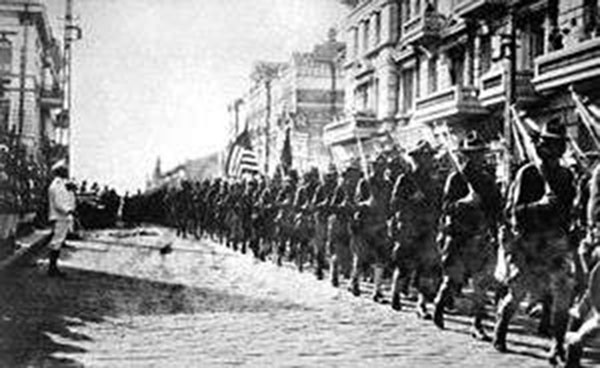
The U.S., Britain, France, and other countries joined Russian counter-revolutionaries in a battle to overthrow the new revolution. This was the Civil War of 1918-1921, pitting the “White” armies and their imperialist backers against the revolution’s fledgling Red Army. The U.S. sent a “White” army of 13,000 to Siberia: 5,000 to Arkhangelsk and 8,000 to the port city of Vladivostok (shown here).
Case #50: U.S. Intervenes to Crush the 1917 Russian Revolution
THE CRIME: One hundred years ago, in October 1917, the Russian people, led by V.I. Lenin and the Communist (or Bolshevik) Party, rose up in revolution and overthrew the country’s old, oppressive system rooted in capitalism and feudalism. It was an earth-shaking, earth-changing event. It was the first attempt in modern history to build a society free from exploitation and oppression, aiming for a communist world. This socialist revolution electrified people the world over, and served as an inspiration and model of what they, too, could achieve.
But the U.S. and oppressors in Russia and the world over saw this liberating revolution as a nightmare and a threat, and they immediately moved to crush it. Over the next several years their assaults took the lives of millions in the new society. Read more.
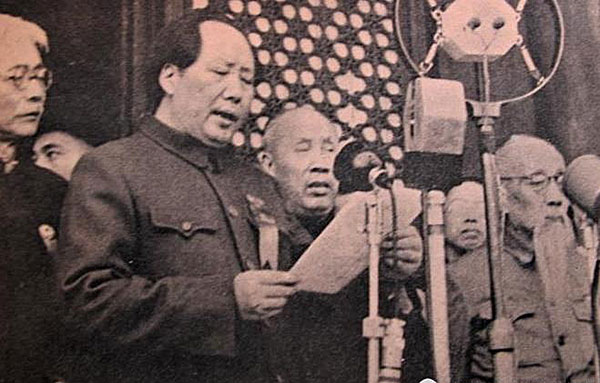
Mao Zedong declared, "The Chinese People have stood up!" October 1, 1949
Case #49: 1950-53—Encircling, Threatening and Attacking the Chinese Revolution
THE CRIME: During the Korean War, the U.S. directly threatened China, including with invasion, war and nuclear attack. This U.S. aggression took the lives of nearly a million Chinese volunteers between 1950 and 1953.
Japan first occupied Korea, a country whose existence stretches back some 1,000 years, in the early 1900s. In 1945, after Japan’s defeat in World War 2, the U.S. and the Soviet Union agreed to temporarily divide the country with the Soviets controlling the area north of the 38th parallel and the U.S. the area to the south. The U.S. quickly set up a repressive, pro-imperialist puppet government. The Soviet Union backed the formation of a nationalist, pro-socialist Korean government (the Democratic People’s Republic of Korea) and its troops left in 1948. Read more.
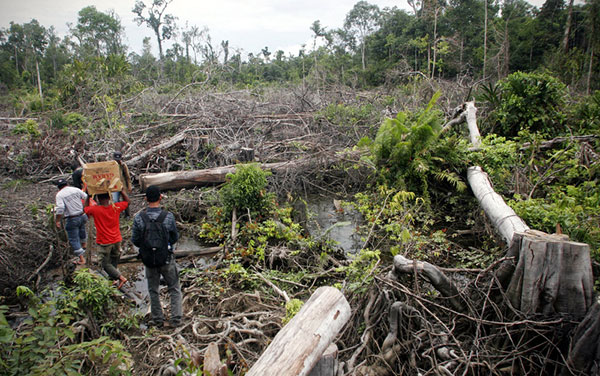
According to the World Wildlife Fund, an area the size of 300 football fields of rainforest is cleared each hour in Indonesia, Malaysia and other equatorial countries to make way for palm oil production. Here villagers walk through swamp forest that has been cleared to convert it into a palm oil plantation. Photo: AP
Case #48: Destroying Indonesia's Rainforests for Palm Oil
THE CRIME: In Indonesia, Malaysia, and other South Asian areas, giant multi-national agribusinesses and food corporations from the United States and other countries are driving a ruthless process of seizing ancient, precious, and irreplaceable tropical rainforest land. Indigenous peoples living there are driven out and their communities are destroyed. Beautiful forests are clear cut and burned, destroying their rich ecology and beautiful and abundant animal and plant life.
This significantly accelerates the global environmental crisis threatening the entire planet by unleashing gigantic quantities of carbon dioxide (CO2) and other greenhouse gases while destroying forests that absorb CO2. All this is being done to profit from the production of palm oil for the global market. Read more.
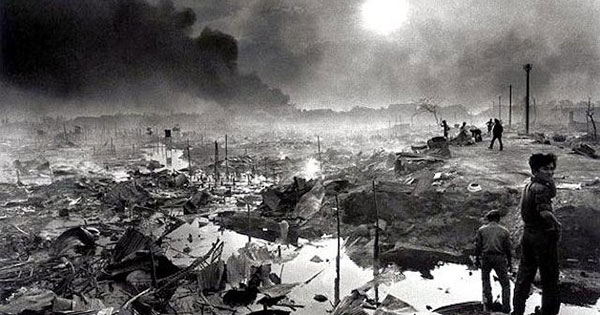
In some large areas of Cambodia, U.S. bombing site maps show almost every square mile of land was hit. Bombing Cambodia wasn’t part of a strategy of “peace.” It was part of a strategy to win the war—or at least prevent a humiliating American defeat and end it on terms favorable to U.S. imperialism.
Case #47: The Bombing of Cambodia, 1969-1973
The Crime: On the night of March 18, 1969, at the height of the Vietnam War, 60 U.S. B-52 bombers began raining explosives from the skies over Cambodia. A U.S. official said at the time “We had been told ... that those carpet bombing attacks by B-52s were totally devastating, that nothing could survive.”
Thus began America's first campaign of saturation aerial bombing. It was called "Operation Menu" and for the next 14 months, a total of 3,800 air strikes of B-52 and F-111 bombers dropped 108,823 tons of explosives on this Southeast Asian country less than half the size of California. Cambodia (and Laos) shared a border with Vietnam, and the Hồ Chí Minh trail (named after the North Vietnamese leader), a military and supply route for the Vietnamese liberation forces, ran through Cambodia. This highly effective military and logistical supply route, and the Vietnamese bases along it, were the main targets of the U.S. bombing. But these were not “surgical strikes”—wide swaths of the lush countryside were obliterated, and the U.S. bombed anything that moved. Read more.
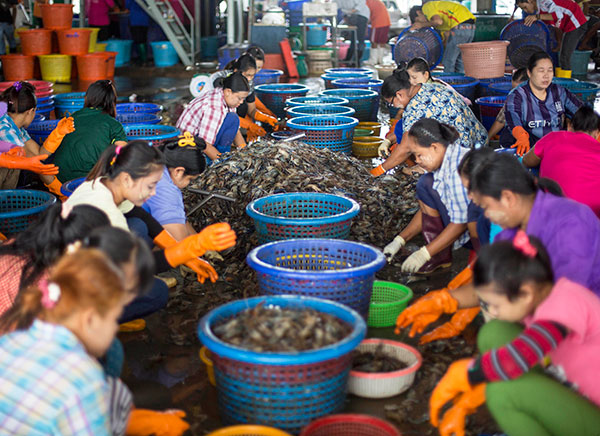 Shrimp caught by slaves on Thai boats are cleaned and peeled in steamy, inhumane factories and sheds. Thailand exports nearly 50 percent of its annual catch to the U.S. The U.S. government has long criticized Thai seafood industry and Thai authorities for human trafficking and indentured labor but has done little to prevent it. Photo: AP
Shrimp caught by slaves on Thai boats are cleaned and peeled in steamy, inhumane factories and sheds. Thailand exports nearly 50 percent of its annual catch to the U.S. The U.S. government has long criticized Thai seafood industry and Thai authorities for human trafficking and indentured labor but has done little to prevent it. Photo: AP
Case #46: Slavery in Thailand's Shrimp Industry
THE CRIME: Americans certainly love their shrimp. They consume more of it than any other seafood, 1.3 billion pounds a year, about four pounds per person. Most of the shrimp have been peeled and cleaned, so consumers can conveniently move them straight from the refrigerator to the skillet. What most Americans don’t know, and what is largely hidden from them, is what makes it possible for them to enjoy their favorite seafood: workers who have been enslaved, often held in debt bondage and by other means, in Thailand, where a major portion of America’s shrimp comes from.
Seafood is a major, $7 billion industry in Thailand, employing 650,000 workers, and it’s anchored by tens of thousands of slave laborers. Most are impoverished migrant fishermen from Cambodia, Laos, and Myanmar desperate to find any work they can. As Thailand’s seafood export industry has expanded in recent years, agents have begun recruiting migrant children and the disabled. They lie about wages and drug and kidnap migrants, who are sold to Thai captains of fishing vessels or the companies that own them. A slave costs about $1,000 to buy, and the workers are forced to pay off their “debt” with their wages, which often aren’t paid for months, years, or sometimes not at all. Read more.
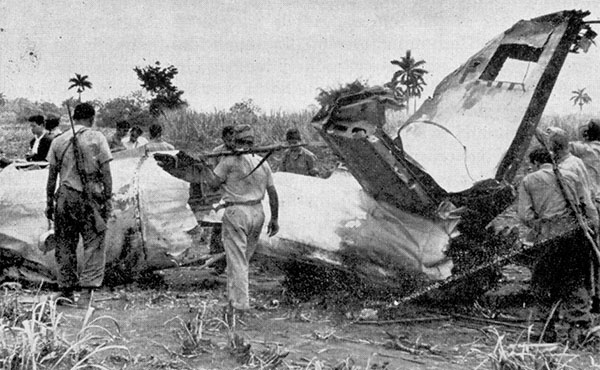
B-26 of mercenary shot down.
Case #45: The Bay of Pigs Invasion, 1961
THE CRIME: On April 15, 1961, a mercenary army of Cuban counter-revolutionary exiles (often referred to as “gusanos,” “worms” in Spanish) launched an attack on Cuba with the intent of overthrowing the Cuban government of Fidel Castro. They were organized, armed, and led by the U.S. Central Intelligence Agency (CIA).
........
The plan began to unravel even before the first invaders reached shore.... Read more.
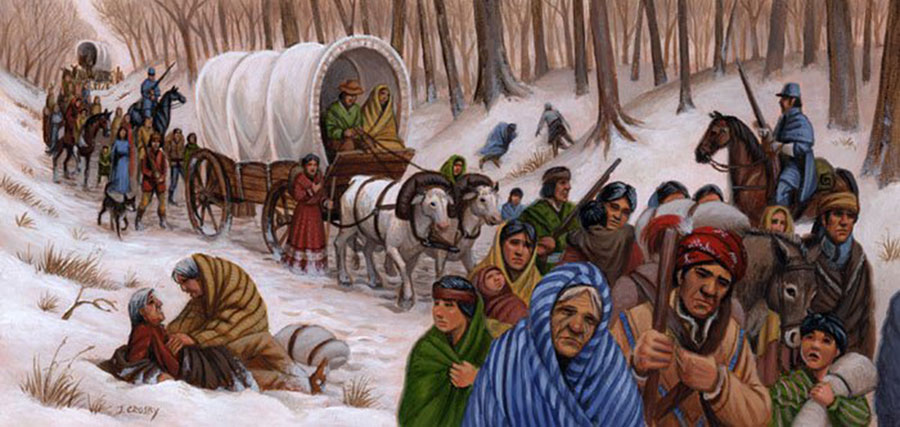
Trail of Tears
Case #44: The Trail of Tears, 1838-39
THE CRIME: From 1838-1839, approximately 15,000 Cherokee and 2,000 Black slaves that they owned were forcibly removed from Cherokee lands in Georgia and force-marched by the military 800 miles to the new “Indian Territory” in an area that later became Oklahoma. On that march, it has been estimated that 2,500-4,000 people died. That seven-month march has become known as The Trail of Tears.
This brutal and forced removal of the Cherokees is just one part of what should be known about the Trail of Tears. The Trail of Tears is actually the removal of five “civilized” tribes from their native lands in Southeastern U.S. to the West: the Choctaws from Mississippi, the Seminoles from Florida, the Chickasaw from Tennessee, the Creek from Alabama, and the Cherokees from Georgia. Read more.
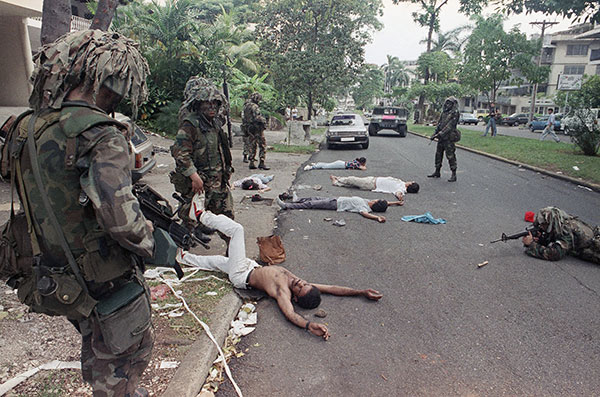
Panama invasion, December 20, 1989. Photo: AP
Case #43: The U.S. Invasion of Panama, 1989-1990
THE CRIME: On December 20, 1989, the U.S. military invaded Panama with 27,684 troops and 300 aircraft, killing thousands of civilians and removing Manuel Noriega and his Panamanian Defense Force (PDF) from power. The invasion was given the name of “Operation Just Cause” by U.S. Secretary of Defense Dick Cheney.
........
The Central American Human Rights Commission (CODEHUCA) reported, “The most devastated civilian neighborhoods—such as Chorrillos and San Miguelito—were extremely poor, densely populated areas. Half of the neighborhood of Chorrillos—which had a pre-invasion population of approximately 25,000—was literally destroyed by US troops and civilian residents were victims of direct attacks.” Read more.
Case #42: COINTELPRO—The FBI Targets the Black Freedom Struggle, 1956-1971
THE CRIME: From 1956-1971, the FBI operated a covert, illegal program that targeted the system’s political opponents in the U.S. The program, COINTELPRO (for COunter INTELligence PROgram), was used to infiltrate, harass, disrupt, smear, and murder or destroy individuals and organizations. COINTELPRO targeted the Black civil rights and liberation movements, communists, socialists, nationalist independence movements, the New Left (student radicals, the antiwar movement), and gay rights and environmental activists.
........
But it was Black people and their movement for equal rights and liberation that Hoover was most aggressively out to crush. Read more.
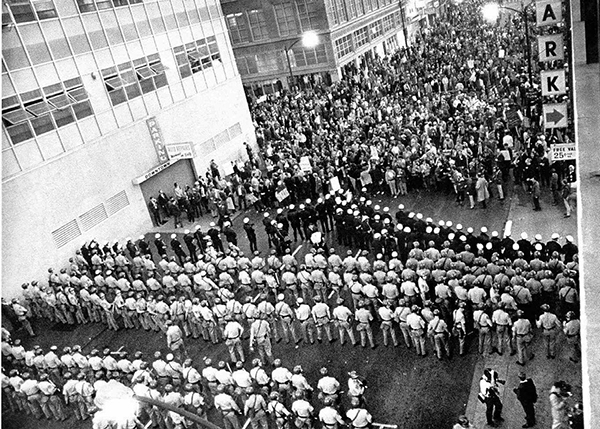
Stop the Draft Week: “From Dissent to Resistance”, Oakland CA, 1967 (Photo: AP)
Case #41: COINTELPRO—The FBI Targets the New Left, 1964-1971
THE CRIME: From 1956-1971, the FBI operated a covert, illegal program that targeted the system’s political opponents in the U.S. The program, COINTELPRO (for COunter INTELligence PROgram), was used to infiltrate, harass, disrupt, smear, and murder or destroy individuals and organizations. COINTELPRO initially targeted the Black civil rights and liberation movements.
From 1964-1971, COINTELPRO targeted student activists and the anti-Vietnam War movement, known as the New Left. COINTELPRO operatives worked with the local police and “red squads” to target individuals to be arrested. Dirty tricks were used to try to foment disputes between and split up political organizations. The FBI coordinated raids with the local police, and worked in conjunction with local police to attack demonstrations where nonviolent protesters were brutally beaten and murdered. Read more.

Native Americans from an Apache tribe entering Carlisle School in 1890. Read more to see what happens to them.
Case #40: North American Indian Residential Schools, 1870-1970s: “Kill the Indian, Save the Man”
THE CRIME: The cultural genocide of the North American Indians.
The near extermination of the Native Americans in the centuries following 1492 is one of the great historical crimes committed by the rulers of this country—or any country. Credible estimates of the indigenous population in North America in 1492 are between 12.5 and 18.5 million. Through the combination of massive epidemics and the “Indian Wars” waged by the U.S. Army through the decades after the Civil War, by 1890 the estimated Native American population had been reduced to fewer than 240,000 in the U.S., and in Canada a third of that—a population reduction of 95 to 99 percent.
Beginning in the 1870s and lasting a century or more, the weight of U.S. policy toward the Native American population shifted from military annihilation to the forced “assimilation” of the survivors—making them “suitable” to be members of the society that had devastated and despised them. Read more.
Case #39: The Palmer Raids of 1919-1920
THE CRIME: In the wake of the 1917 Russian Revolution and following World War 1, revolutionary movements and organizations spread throughout the world, including in the U.S. Beginning November 1919 and continuing into 1920, the Department of Justice (DOJ) launched the Palmer Raids: massive raids targeting immigrants, communists, socialists, radicals, and anarchists. Their stated targets were “the Reds”—anyone suspected of sympathy with the Russian revolution or membership in any communist or anarchist organization. Read more.
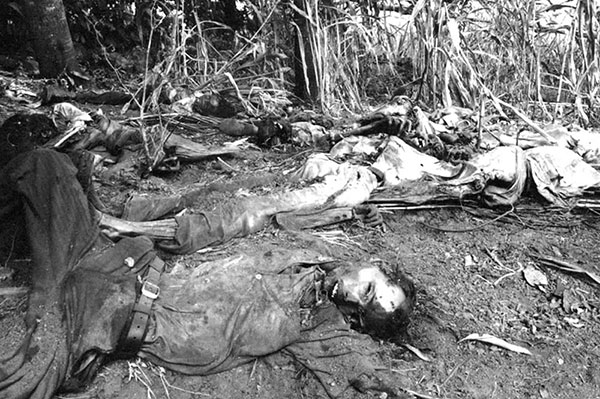
Operación Rescate (“Operation Rescue”) was part of the “anti-guerrilla campaign,” but there were no combatants in El Mozote. The villagers (some shown here), completely unarmed, were massacred during the Reagan administration.
Case #38: The U.S. Backs El Salvador’s Death Squad Government, 1980 to 1992
THE CRIME:Throughout the decade of the 1980s into the early 1990s the U.S. government backed, trained, and financed the reactionary government and military of the Central American country of El Salvador in its murderous counterinsurgency war that killed tens of thousands of workers, peasants, students, intellectuals, artists and others and forced hundreds of thousands to flee into exile.
El Salvador was dominated by U.S. imperialism in league with a few Salvadoran families who controlled the vast majority of the country’s land and wealth, while millions of peasants, workers and others lived in extreme poverty. They had no democratic rights and during the 1960s and 1970s their political protests were violently suppressed. In 1977, the Salvadoran military killed hundreds peacefully protesting voter fraud. The Salvadoran government unleashed paramilitary vigilante groups or “death squads” against its opponents, kidnapping and murdering leaders of labor unions, peasant organizations, political parties, and guerrilla groups, as well as priests and lay religious workers who sided with the poor. Read more.
Case #37: December 26, 1862: The Lynching of 38 Dakota Men―The Largest Mass Execution in U.S. History
THE CRIME: On December 26, 1862, in the midst of the U.S. Civil War (April 1861-May 1865), and in the same week that the Emancipation Proclamation was issued, President Abraham Lincoln ordered 38 Dakota Santee Sioux men sent to the gallows in Mankato, Minnesota. They were hooded and hanged simultaneously from a single scaffold, surrounded by 1,500 Union troops and a howling lynch mob of 4,000 white settlers. It was the largest mass execution in U.S. history. Read more.
Case #36: August 28, 1955: The Torture and Lynching of Emmett Till
THE CRIME: On Sunday, August 28, 1955, two white supremacists, Roy Bryant and J.W. Milam, tortured, mutilated, and murdered Emmett Till, a 14-year-old Black youth.
They tied Emmett up and took him to a barn where they savagely beat and tortured him. Bryant and Milam gouged out Emmett’s eyes, and hacked off his tongue and pieces of his ear. They cut the bridge of his nose, broke both his wrists and a leg bone, and split open his head. Then they shot him in the head with a .45-caliber pistol. They tied Emmett’s lifeless body to a 70-pound cotton gin fan blade with barbed wire, and then threw him in the Tallahatchie River.
Hundreds of thousands of people across the U.S. and worldwide denounced and fiercely protested Emmett Till’s murder and this sham trial. A few months later, Look magazine paid Bryant and Milam $4,000 for an interview. The two men openly bragged about brutalizing and murdering Emmett Till. Read more.
Case #35: The 2011 U.S.-NATO War on Libya
THE CRIME: In February 2011, in the context of the Arab Spring uprisings in neighboring Tunisia and Egypt, sections of Libyan society rose up against Muammar Qaddafi’s oppressive, 42-year-long rule. The Qaddafi regime responded by violently suppressing the protests. In this context, at the insistence of the U.S., France, and Britain, the UN Security Council passed Resolution 1973, giving the UN authority to militarily intervene in Libya. The UN resolution called for a humanitarian effort to save the lives of pro-democracy protesters endangered by Qaddafi’s forces who were threatening to bomb their stronghold in Benghazi, the country’s second-largest city. Within 48 hours, the U.S. and other NATO countries established a “no-fly zone” throughout Libya and started bombing Qaddafi’s forces. For the next seven months, 19 NATO countries carried out massive military operations throughout Libya. They deployed aircraft carriers with warplanes, amphibious warships, torpedo jets, surveillance planes, submarines, and U.S. missile-armed Predator drones. Though the bulk of the bombings and killings were carried out by the U.S., Britain, France, and Canada, at its peak the war involved 21 NATO ships and more than 250 aircraft of all types. Over 8,000 U.S. military personnel took part and U.S. aircraft bombed Libya 14,202 times. These aerial attacks included B-2 stealth bombers that were each armed with 16 2,000-pound bombs. Read more.
Case #34: America’s 1972 Christmas Bombing of North Vietnam
THE CRIME: The Democratic Republic of Vietnam (called “North Vietnam” by the U.S.), its People’s Army, and the National Liberation Front (NLF) in South Vietnam had been waging a just people’s war for national liberation against the U.S. since 1961 (and before that the Vietnamese had been fighting the French colonialists). The U.S. had been bombing the Democratic Republic of Vietnam and the liberation fighters in the south since 1965, but its “Christmas bombing” in 1972 was the most intense and devastating air offensive of the entire war. Read more.
Case #33: The 1944 Lynching of 15-Year-Old Willie James Howard for Writing a Christmas Card to a White Girl
THE CRIME: In December 1943, Willie James Howard, a 15-year-old Black youth, was in the 10th grade in Live Oak, Florida, and working at the local dime store. For Christmas, Willie James gave cards to all his co-workers, including a 15-year-old white girl named Cynthia Goff. He signed the card to Cynthia “with L.”
Apparently, Willie James heard that Cynthia was upset about receiving the card. On New Year’s Day, he delivered a second note to explain, saying, “I know you don’t think much of our kind but we don’t hate you all. We want to be your friends but you won’t let us... I wish this was [a] northern state. I guess you call me fresh. Write an[d] tell me what you think of me good or bad... I love your name. I love your voice, for a S.H. [sweetheart] you are my choice.” Read more.
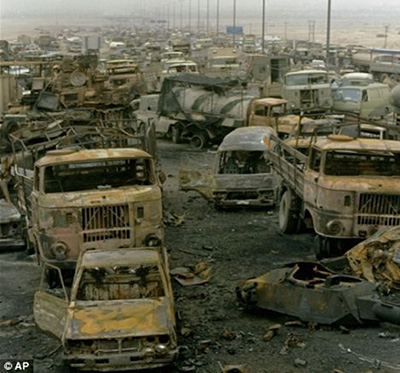
On February 25, 1992, U.S. forces attacked a convoy of retreating Iraqi forces. For 48 hours Coalition aircraft and ground forces slaughtered thousands along the six-lane “highway of death.” Photo: AP
Case #32: The 1991 Persian Gulf War – “Operation Desert Storm”
THE CRIME: From January 16 until February 27, 1991, the U.S. led a massive war of aggression, based on lies, against Iraq, a war which killed some 100,000 Iraqi soldiers, wounded another 300,000, and led to the deaths of 70,000 civilians by January 1992.
On August 2, Iraq’s army invaded and occupied the neighboring country of Kuwait, a U.S. ally. President George H.W. Bush denounced Iraq’s action as “unprovoked aggression” and declared that it “will not stand.” Over the next five months, the U.S. built a military coalition and deployed more than 500,000 American and 200,000 allied troops to the Persian Gulf. The U.S. and its allies pushed through UN Security Council resolutions demanding an Iraqi withdrawal and the imposition of punishing sanctions.
Throughout these months, Bush claimed that “America does not seek conflict.” Yet Bush and his team rejected Iraqi leader Saddam Hussein’s offers to leave Kuwait, and at least 11 other international proposals to head off a U.S. attack. Bush secretly told his cabinet, “We have to have a war.” Read more.
Case #31: Double Murder by Police in Chicago—on the Night After Christmas
THE CRIME: On the night of December 26, 2015—the night after Christmas—Antonio LeGrier called 911 because his 19-year-old Black son, Quintonio, was struggling with mental health issues and his family wanted help. Antonio called Bettie Jones, a 55-year-old Black woman who lived downstairs, to alert her to his son’s situation and let her know to be on the lookout for the police.
Bettie’s daughter Latisha told reporters afterwards that her mother had gone to the door—presumably to let the cops in the building—and then Latisha heard shots. She rushed to the hall to find her mother and Quintonio lying there bleeding. As Latisha came to the doorway, the police threatened to shoot her as well. One bullet fired by the police went through the front door and through several rooms in Bettie Jones’ home.
According to the two cops, when they entered the lobby Quintonio was coming down the stairs from the second-story flat carrying an aluminum bat. The cops backed up, but Robert Rialmo—the cop who opened fire killing both Quintonio and Bettie—said Quintonio came at him swinging the bat, giving him no choice but to shoot Quintonio to save his own life. He claimed Bettie Jones was standing behind the youth and was shot “by accident.” Read more.

Palestinian family escaping the bombing in Southern Gaza Strip, 2008. Photo: AP
Case #30: Israel’s U.S.-Armed and -Backed Massacre in Gaza (2008-2009)
THE CRIME: From December 27, 2008 to January 19, 2009, Israel, backed by the U.S., brutally and viciously attacked the Palestinian people in Gaza—a Palestinian territory on a small strip of land 25 miles long and five miles wide on the eastern coast of the Mediterranean Sea, bordered by Egypt on the south and Israel on the east and north. Overwhelmingly, the Palestinian people in Gaza were driven from their homes in what is now Israel. The violent expulsion of the Palestinians from their homeland was most ferocious during the Nakba (Arabic for catastrophe) in 1948. Israel has kept more than 1.5 million Palestinians in Gaza with no way out. (See the Revolution/revcom.us special issue, Bastion of Enlightenment…or Enforcer for Imperialism: The Case of Israel.)
The number of Palestinians killed during the 24-day assault, which Israel called “Operation Cast Lead,” has been estimated to be between 1,166 and 1,417, including 844 civilians, 281 of them children. More than 3,000 were injured during the invasion. Read more.

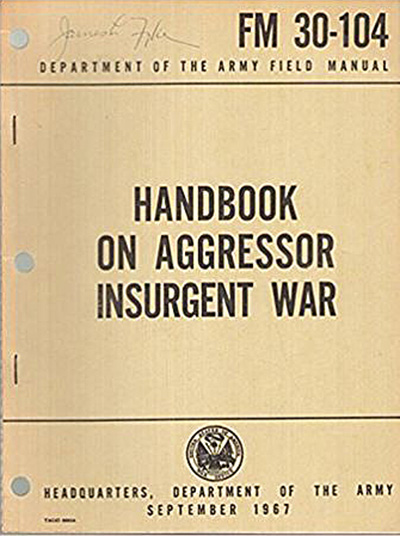
Nicaraguan woman buries her child murdered by the Contras. Contras, mercenaries trained by the CIA at School of the Americas in Fort Benning, Georgia, were responsible for the slaughter of more than 8,000 Nicaraguans civilians, and 910 state officials, as well as other atrocities and crimes against humanity.
Case #29: Contra War of Terror in Nicaragua 1979-1989
THE CRIME:
The U.S. has had its claws dug deeply into the small Central American country of Nicaragua for over 150 years. It landed its Marines there 12 different times between 1853 and 1933. After Nicaraguan rebels, led by Augusto César Sandino, finally drove U.S. forces from their country in 1934, the U.S. had him assassinated and installed a military dictatorship under Gen. Anastasio Somoza García, whose family, in league with the U.S., brutally ruled Nicaragua for the next 43 years.
In 1979, after the Sandinista National Liberation Front (FSLN) overthrew Anastasio Somoza (the son of Gen. Somoza Garcia) and his regime, the U.S. launched a savage, decade-long counter-revolutionary war against the people of Nicaragua. It built up a reactionary proxy army to wage war to weaken, destabilize, and attempt to overthrow the new Sandinista-led regime, which had established ties with the Soviet Union, the U.S.’s main imperialist rival at the time. Read more.
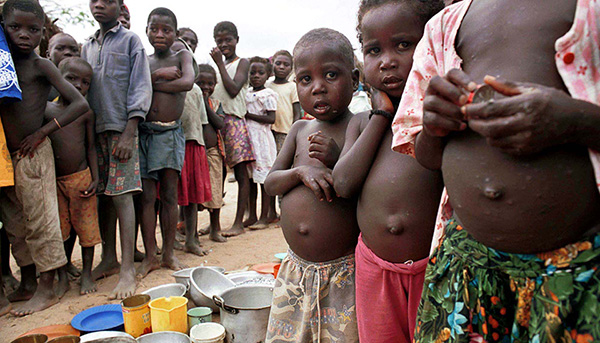
In the aftermath of more than 25 years of civil war, three in ten children did not survive to their fifth birthday. Above, malnourished Angolan children. (Photo: AP)
Case #28: U.S. Foments Bloody Civil War in Angola, 1975-2002
THE CRIME: For 27 years, from 1975 to 2002, the U.S. fueled a reactionary and immensely bloody civil war in Angola, a country in Southern Africa. The war led to the deaths of some half a million Angolans and millions were driven from their homes.
In 1975, after years of struggle by the Angolan people, Portugal—which had dominated that area of Africa for centuries—was forced to grant independence to Angola and its other African colonies. The U.S. had supported Portugal in its efforts to crush the opposition and sustain its colonial rule of Angola, including by providing the colonizers with napalm...
By 2002, about 500,000 Angolans had been killed and millions internally displaced. The widespread use of land mines resulted in one of the highest amputee rates in the world. The aftermath of the civil war left Angola with much of its public institutions, economic enterprises, religious institutions, infrastructure, and medical and other basic life support systems in ruins. Read more.

Mexican army soldiers beat demonstrators in the Plaza of the Three Cultures area of Mexico City, a slaughter that came to be known “Tlatelolco massacre.” (Photo: AP)
Case #27: October 2, 1968: The U.S. Hand in the Mexican Government’s Massacre of Hundreds of Students at Tlatelolco
THE CRIME: On October 2, 1968—Ten days before the start of the 19th Olympic Games in Mexico City—10,000 students and other supporters of a months-long student upsurge gathered for a meeting and rally in the Plaza de las Tres Culturas in the Tlatelolco section of Mexico City. The students had made clear they weren’t going to march on the Olympic Village, but some 5,000 soldiers, 300 government tanks, jeeps, and armored cars, and hundreds of police surrounded the plaza nonetheless.
At 6:10 pm, flares were fired into the sky from a helicopter. Suddenly, out of nowhere, shots were fired from the upper floors of the Chihuahua apartment building overlooking the crowd, where many students were gathered.
The troops immediately responded by raking the crowd with machine-gunfire. Soldiers with fixed bayonets advanced from two sides—there was no escape. Tanks opened fire on the apartment complex, where student leaders had been speaking from a balcony...
The night of October 2 became known as the Massacre in Tlatelolco. Read more.
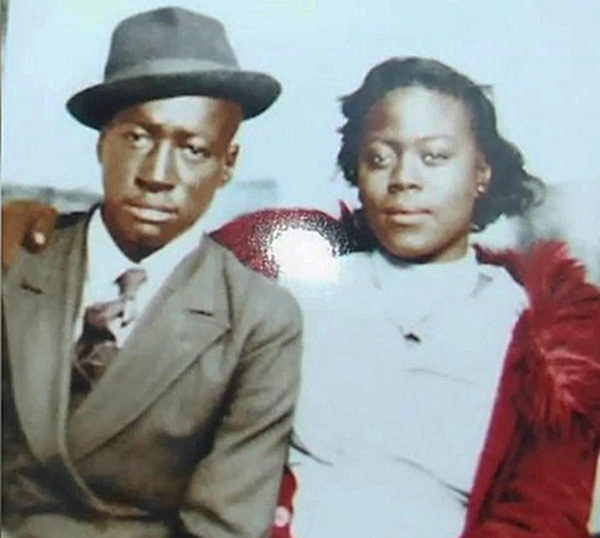
Roger and Dorothy Malcom
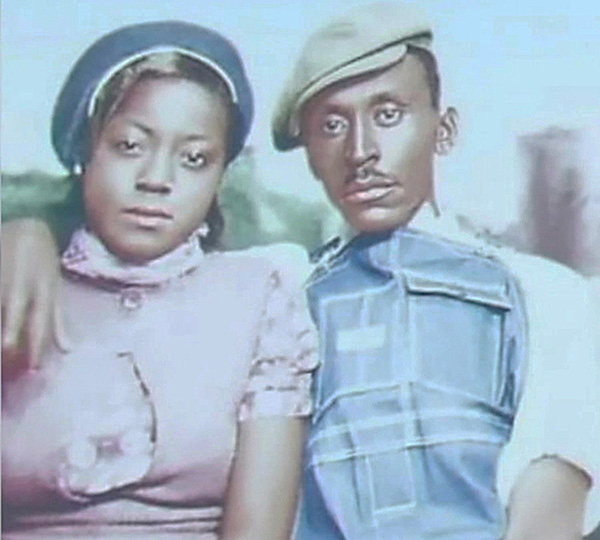
Mae Murray and George Dorsey
Case # 26: The 1946 White-Mob Lynching of Two Black Couples at Moore’s Ford, Georgia
THE CRIME: In the summer of 1946, a white lynch mob near Moore’s Ford Bridge in Monroe, Georgia (a small rural town about 50 miles east of Atlanta), brutally murdered four Black sharecroppers. Despite abundant evidence, eyewitness accounts and two investigations by the FBI (60 years apart), there has never been a single indictment.
The bodies of George, Mae, Roger, and Dorothy were found disfigured beyond recognition. Bullets fired at point-blank range filled the victims’ faces and arms. George Dorsey’s body lay face down on the ground with bullet and shotgun wounds covering his arms, head, and back. They singled out Roger Malcom for the worst punishment—a shotgun blast exploded his face and a 10-foot-long rope encircled his neck. Another rope held his hands tied to George’s. Dorothy Malcom’s disfigured face pointed toward her husband, Roger. Dorothy’s body touched Mae Murray Dorsey’s. Mae was closest to the road—her body was in a crouched position, a large-caliber bullet had pierced the back of her skull. Read more.
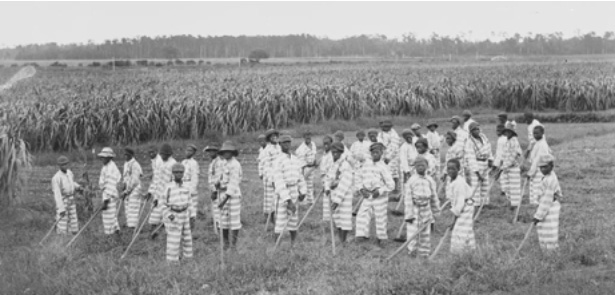
Child prisoners used in leased-convict labor, 1903 Credit: John L. Spivak, Library of Congress, Prints & Photographs Division, Detroit Publishing Company Collection, Public Domain
Case #25: The “Neo-Slavery” Killing Fields of Sugar Land, Texas: 1878‑1911
THE CRIME: In early 2018, a construction crew in Sugar Land, Texas, a fast-growing suburb 20 miles outside of Houston, accidentally discovered 95 shallow unmarked graves. The 94 Black men and one Black woman whose remains were found were as young as 14 and as old as 70 when they died. Rusted farm tools and chains were also found at the site, including chains with swivels on them, likely used in chain gangs. The bodies had been buried over 100 years ago in pine boxes just two to five feet under the earth’s surface. This accidental find has now revealed something of their painful story and a gruesome chapter in the ugly history of America’s treatment of Black people.
Archeologists who have begun to study this site date the bodies back to 1878-1911. They found signs of horrific injuries on the skeletons, ranging from bone infections and “shackle poisoning” (when human skin rubs against rusty metal shackles causing potentially fatal infections) to healed bone breaks and “bones distorted by heavy labor and muscles torn away from the skeleton,” according to the New York Times. Many of the bones unearthed were deformed in the same ways, which indicate that they bore the repeated stress of incredibly hard labor. Read more.
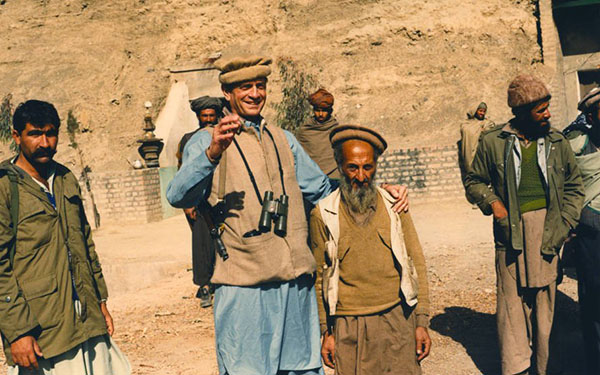
U.S. Congressman Charlie Wilson with reactionary Islamic mujahideen fighters. During the Reagan years, Wilson played a key role arranging U.S. arming and funding of the Afghan mujahideen, including with Stinger anti-tank and anti-aircraft missiles. (Photo: Public Domain)
Case #24: U.S. Proxy War Against the Soviet Union in Afghanistan, 1979-1988
THE CRIME: In July 1979, the U.S. began a covert campaign to destabilize Afghanistan’s new pro-Soviet government and lure the Soviet Union, at the time their main imperialist rival, into invading Afghanistan. In December 1979, after the Soviets invaded with 100,000 troops, the U.S. organized and led a bloody, decade-long proxy war against them and their Afghan client regime with one focus: bleeding the Soviet Union white and “killing Russians.”
The U.S. and its allies Saudi Arabia and Pakistan organized, trained, and funded reactionary Islamic fundamentalist mujahideen (Islamic fighters) to carry out the war. After Ronald Reagan took power in 1981, the U.S. launched a global campaign to recruit the most radically anti-communist Islamists—“ideologically charged with the spark of holy war” as author Mahmood Mamdani reports—not only from within Afghanistan, but from all over the world. Jihadist clerics, such as the very prominent Sheikh Abdullah Azzam, under the CIA’s patronage were sent around the globe preaching that it was a religious duty for Muslims to fight in Afghanistan and actively recruiting fighters. The U.S. and its allies also spread fundamentalist ideology through a growing worldwide network of Islamic schools—madrassas. Read more.

Case #23: The Afghanistan and Iraq War Logs and the Persecution of Chelsea Manning, Julian Assange, and WikiLeaks
THE CRIME: In July 2010, WikiLeaks, working with a number of major mainstream media outlets including the New York Times and the Guardian, published 77,000 classified U.S. military documents chronicling incidents in the U.S. war in Afghanistan from 2004 through 2009. Then in October, it published another 392,000 classified documents detailing U.S. military actions in the Iraq war, also from 2004 through 2009. All these documents and more were sent to WikiLeaks by U.S. Army whistleblower Private Chelsea Manning.
These reports were written by U.S. military personnel—so some facts and descriptions in them may be skewed, incomplete, censored, or covered up. But they were never meant to become public. And they graphically indicate the depth and extent of mass murder of civilians, torture, and war crimes carried out by U.S. forces under George W. Bush and Barack Obama in Afghanistan and Iraq.
The Obama administration immediately responded to the publication of the war logs by launching an intensive hunt for the whistleblower who leaked the documents and a global campaign to take down WikiLeaks and its founder, Julian Assange. Chelsea Manning was eventually arrested, tried in a military court and sentenced to 35 years in prison—the longest sentence ever given a whistleblower. Her sentence was commuted in 2017—but only after she had spent seven years in prison, 11 months of it in 23-hours-a-day isolation that a UN Special Rapporteur on torture deemed “cruel and inhumane.” She was denied critically needed medical care related to being a transgender woman. Read more.
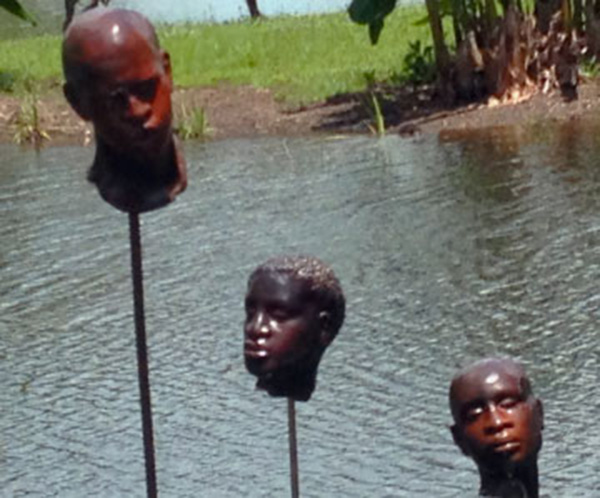
New Orleans authorities responded to the slave uprising by chopping heads off corpses and putting them on pikes. Nearly 100 heads on pikes were displayed in central New Orleans and along River Road. The Whitney Museum commissioned Woodrow Nash to create 63 ceramic heads depicting the revolutionaries.
Case #22: The Barbaric Suppression of the 1811 Louisiana Slave Uprising
THE CRIME: They moved downriver, nearly 25 strong, the heavy night rain silencing their approach. Forty miles from New Orleans, they break into the mansion, run to the second floor where they find and wound with an axe the slave owner Manuel Andry and kill his son. They then break into the mansion’s basement, collect muskets and ammunition, take several horses, and continue to march downriver.
So began, on January 8, 1811, the largest slave revolt in U.S. history, an armed revolt against the slavery system’s barbaric, intolerable conditions. And a revolt the slave owners and U.S. authorities violently suppressed using the most savage means imaginable. The rebels’ political goal was to establish an independent Black republic on the shores of the Mississippi, with a captured New Orleans as its capital.
It is precisely because of the highly developed nature of the revolt and its political aim of establishing an independent Black republic that the slave owners and U.S. authorities set out to mercilessly crush the rebellion, to savagely place on pikes the heads of 100 rebels and display their mutilated bodies—providing a glimpse, just a brief but crystal clear glimpse, into the utter barbarity of the slave system. Read more.
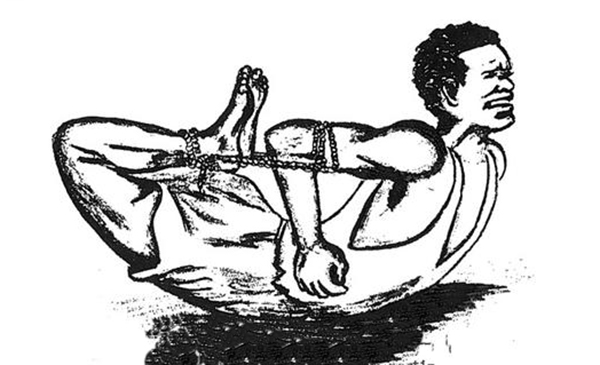
One of the tortures people suffered was the “Arbatachar”—where all four limbs are tied behind the victim’s back, the cord yanked tight until the chest is thrust forward. This left some victims deformed, paralyzed, or unable to use their limbs at all.
Case #21: Chad, 1981‒1990: U.S. Backs Ruthless Torturer, Mass Murderer Hissène Habré—“Africa’s Pinochet”
THE CRIME: In March 1981, the CIA under newly elected President Ronald Reagan began providing covert backing and military assistance to Hissène Habré, one of the most ruthless warlords fighting to take power in Chad. That U.S. support would continue for eight more years, as Habré seized power, and ruled so ruthlessly he became known as “Africa’s Pinochet,” after Chile’s U.S.-backed butcher, Gen. Augusto Pinochet.
The CIA knew of Habré’s opposition to Qaddafi and his allies in Chad, and they also knew of his warlord atrocities, which had also been reported by the New York Times and Washington Post. This included the discovery of several hundred skeletons of people murdered by his henchmen and buried in the back yard of his home. Nevertheless, in early 1981, Reagan signed a secret presidential finding that authorized covert operations to bring Hissène Habré to power and the CIA, along with France, began covertly supplying Habré with millions of dollars in weapons and other assistance. Read more.
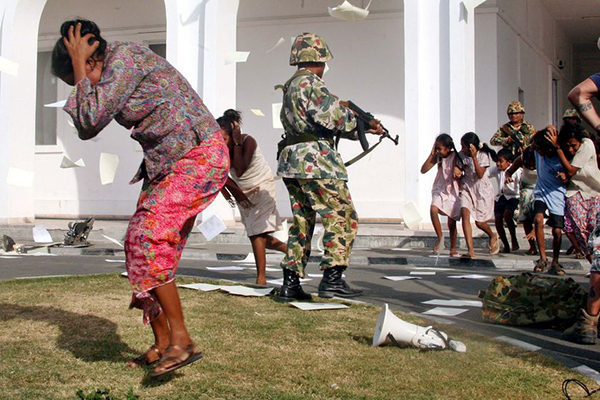
From 1975 to 1999, the Indonesian military – with massive U.S. support – bombed, massacred, tortured, raped, and brutalized the population of East Timor until nearly one-third of the original population had been killed.
Case #20: The U.S.-Enabled Genocide in East Timor, 1975‑1998
THE CRIME: The U.S.-backed Indonesian invasion and occupation of East Timor resulted in the worst slaughter relative to population since the Holocaust. From 1975 to 1999, the Indonesian military bombed, massacred, tortured, raped, and brutalized the population of East Timor until nearly one-third of the original population of 650,000 had been killed. During this time, the U.S. continually gave the military the economic and diplomatic support that enabled this horrific genocide.
Letters smuggled from East Timor spoke of the U.S.-supported horrors they faced:
“Many elements of the population were killed under inhuman conditions of bombardment and starvation.... The waters of the river were filled with blood and bodies. Husbands, fathers, brothers and abandoned wives, sons and brothers all in the same agony.” Read more.
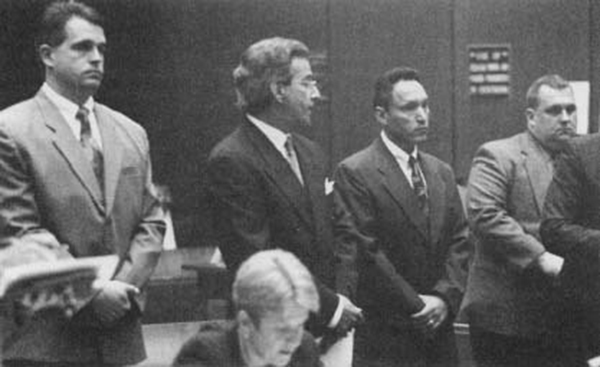 The trial of the four CRASH cops was a damning example of this system at work. The whole charade, including the lack of a vigorous prosecution, was orchestrated to let the cops off. But then the jury went off script and returned a guilty verdict against three of the four cops. LA Superior Court Judge Josephine Connor responded by throwing out the jury verdict! Then in 2008, the reputedly liberal 9th Circuit Federal Court of Appeals even awarded $15 million to those very three cops who had been convicted. (Credit: Wikicommons)
The trial of the four CRASH cops was a damning example of this system at work. The whole charade, including the lack of a vigorous prosecution, was orchestrated to let the cops off. But then the jury went off script and returned a guilty verdict against three of the four cops. LA Superior Court Judge Josephine Connor responded by throwing out the jury verdict! Then in 2008, the reputedly liberal 9th Circuit Federal Court of Appeals even awarded $15 million to those very three cops who had been convicted. (Credit: Wikicommons)
Case #19: The LAPD Rampart Division Scandal: 1996-2000:
Police Murder, Terror and Frame-ups—and the Conspiracy to Get the Cops Off
THE CRIME:In 1999, it was revealed that the Rampart Division of the LAPD and its elite “anti-gang” CRASH unit (Community Resources Against Street Hoodlums) had been carrying out widespread, vicious brutality in the oppressed, largely Spanish-speaking neighborhood of Pico Union that they patrolled.
Dozens of these CRASH cops roamed this small area in street clothes and unmarked cars, sporting tattoos of a skull with a cowboy hat and a pair of aces and eights (“dead-man’s hand”). They gave each other plaques for their “heroic” service, which were exposed as a mountain of crimes against the people including murder, attempted murder, brutality, robbery, extortion, drug dealing, and routinely framing and convicting thousands of people based on lies, planted “evidence,” and trumped-up charges—including against those they had just shot or murdered. Read more.
 1965 Watts Rebellion: More than 5,000 youth were injured or arrested. Photo: AP
1965 Watts Rebellion: More than 5,000 youth were injured or arrested. Photo: AP
Case #18: The LAPD—150 Years of Murder, Brutality, Racism and Repression
THE CRIMES:The LAPD, with its slogan of “To Protect and Serve,” is celebrating its 150th anniversary this year. But what is its actual history—from beginning to today? And what does it say about the actual history of this country and the role of the police?
........
THE CRIMINALS: The entire LAPD, from 1869 until today, all the cops listed above, and all the politicians—Democrats and Republicans—and media who backed them. Read more.
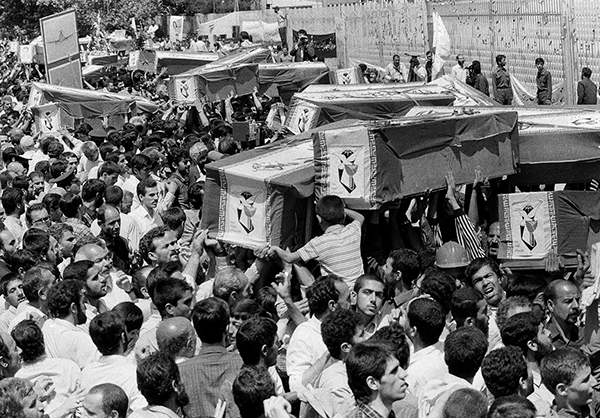 Iranians carrying coffins of the victims of the U.S. airstrike against the Iranian commercial flight 655 in the streets of Tehran. (Photo: AP)
Iranians carrying coffins of the victims of the U.S. airstrike against the Iranian commercial flight 655 in the streets of Tehran. (Photo: AP)
Case #17: Mass Murder in the Skies Over Iran:
The Shoot-Down of Passenger Flight 655… by the U.S. Navy
THE CRIME: At 9:53 on the morning of July 3, 1988, Captain Mohsen Rezaian was piloting Iran Air Flight 655, a civilian airliner on a routine flight from Bandar Abbas, 140 miles across the Persian Gulf to Dubai, normally a 28-minute flight. 290 people were aboard the plane.
Suddenly, without warning, two surface-to-air missiles launched from the U.S. warship Vincennes, 18 miles away, ripped apart his plane which then crashed into the Gulf. All aboard were killed, though only about 200 bodies could be recovered. Read more.
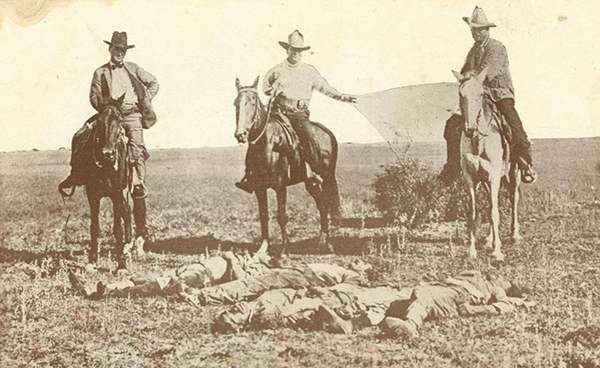 The bodies of three Mexicans who were lynched in Texas, 1915, are dragged to town by three Texas rangers.
The bodies of three Mexicans who were lynched in Texas, 1915, are dragged to town by three Texas rangers.
Case #16: “La Matanza”: A Decade of Lynching & Terrorizing Mexican People in South Texas, 1910–1920
THE CRIME: On November 3, 1910, Antonio Rodríguez was dragged from his job by a posse of armed white men. Without any evidence, they accused Antonio, a 20-year-old ranch worker from a small town in northern Mexico, of murdering a white woman on a nearby farm a day earlier. They beat him and put him in the jail at nearby Rock Springs, Texas. On November 4, in broad daylight, a mob pulled Antonio Rodríguez from his cell and burned him at the stake. No charges were filed against any of the murderers. Read more.
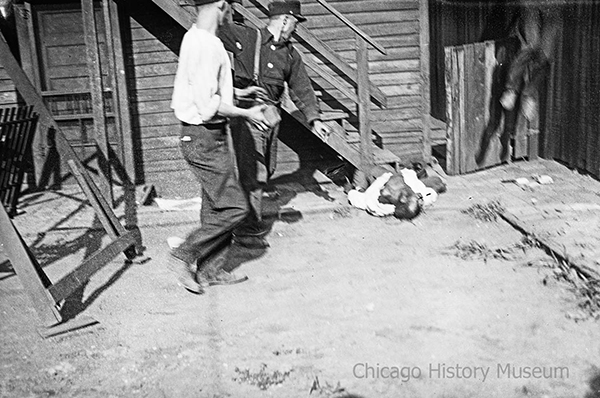 White men stoning an African-American man during the 1919 Chicago Race Riots, Chicago, Illinois.
White men stoning an African-American man during the 1919 Chicago Race Riots, Chicago, Illinois.
Case #15: Chicago 1919: The Racist Riot and the Righteous Resistance
THE CRIME: July 27, 1919. Late in the afternoon of a hot Chicago day, a Black teenager named Eugene Williams and some friends went out into Lake Michigan from an unofficial “colored” beach at 29th Street to cool off and have some fun—a simple act of the kind that has so often proved deadly for Black youth, from that time and before, on down to the present day.
The kids drifted across the invisible line to the adjacent “white” area. “A snarl of protest went up from the whites and soon a volley of rocks and stones were sent in his direction.” A rock struck one of the Black teenagers, knocking him into the water. Black men who were present attempted to go to his rescue, but they were kept back by the whites and the teen died.
This brazen murder by racist whites backed by the cops sparked an immediate clash between Blacks and whites on the adjoining sections of the beach, which spread like wildfire through a large part of the city.
There are various accounts of what happened, but what is clear is that gangs of racist white youths, soldiers, sailors, and other white racists went on a rampage against Chicago’s small Black community, which was less than 5% of the city’s population. Read more.
 People try to cross where a bridge had been wiped out by Hurricane Maria. The entire economic, educational and social infrastructure of Puerto Rico was severely and permanently degraded. Almost all of that was completely un-necessary; it was the result of deliberate inaction by the U.S. government. (Photo: AP)
People try to cross where a bridge had been wiped out by Hurricane Maria. The entire economic, educational and social infrastructure of Puerto Rico was severely and permanently degraded. Almost all of that was completely un-necessary; it was the result of deliberate inaction by the U.S. government. (Photo: AP)
Case #14: Hurricane Maria, Puerto Rico… And America’s Genocidal Response
THE CRIME: On September 20, 2017, Hurricane Maria, with maximum winds of 175 mph, tore through the Caribbean, causing massive death and destruction. Puerto Rico, an island nation of over three million people, took a direct hit.
Around two dozen people died as a direct result of the storm—drowned by flood waters, hit by flying debris, or crushed by falling trees. But in the days, weeks, and months after the storm, thousands more would die, hundreds of thousands would endure great suffering, and the entire economic, educational, and social infrastructure of Puerto Rico would be severely and permanently degraded. Almost all of that was completely un-necessary; it was the result of deliberate inaction by the U.S. government and its refusal to organize a serious rescue and recovery effort for Puerto Rico. Read more.
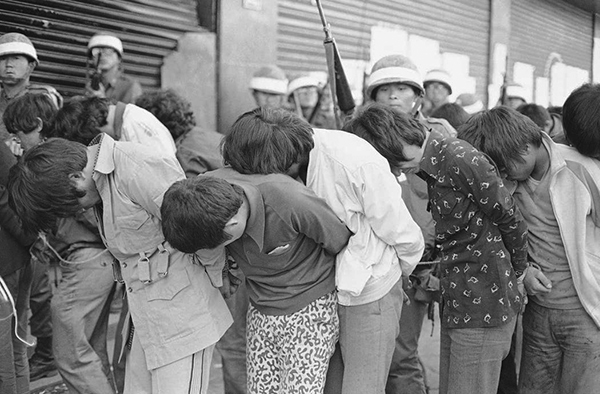
On May 27, paratroopers stormed into downtown Kwangju. They quickly overwhelmed the students, arresting 1,740. Photo: AP
Case #13: South Korea May 18-27, 1980—The Kwangju Massacre
THE CRIME: From May 18-27, the U.S.-backed South Korean military junta of President Chun Doo Hwan massacred as many as 2,000 courageous protesters in the major city of Kwangju (also spelled Gwangju). The U.S. publicly deplored the mass murder and repeatedly claimed it had nothing to do with it. But secretly behind the scenes, it was fully backing and enabling this slaughter.
After the 1950-53 Korean War, South Korea had been ruled by a series of brutal military dictatorships—from 1961-1979 by General Park Chung Hee. All had U.S. support. In 1979, amid a wave of student and mass protests, Park was assassinated. Two months later Gen. Chun Doo Hwan seized power in a coup and declared martial law.
Yet protests continued, demanding democratic rights, with university students and others demanding an end to “the arrests of dissidents and their families and friends, fraudulent elections, torture and unmet social needs.”...Read more.
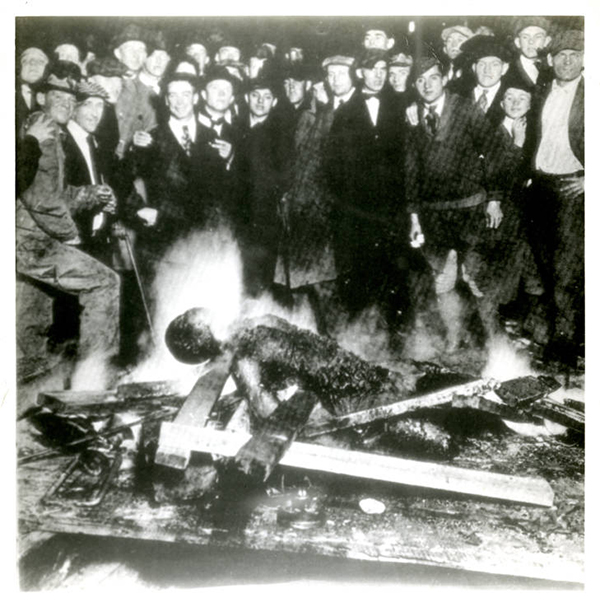
A black man being burned on a bed of lumber during the Tulsa Race Massacre, 1921. Photo: Unsourced Archive
Case #12: The 1921 Tulsa Massacre and the Destruction of Black Wall Street
THE CRIME: On May 30, 1921, Dick Rowland, a 19-year-old Black shoe shiner working downtown, entered the elevator of the only building with a restroom Blacks could use in the area. Sarah Page, a white 17-year-old, was the elevator operator. When the door closed, Page cried out, and Rowland ran off. The most common explanation is that Rowland just stepped on Page’s foot. But Rowland was alleged—without evidence—to have assaulted Page. He was arrested the next morning and held in a jail cell above City Hall.
That afternoon, the Tulsa Tribune ran the headline “Nab Negro for Attacking Girl in Elevator,” suggesting that Page had been raped, and editorialized: “To Lynch Negro Tonight.” Within an hour of the paper hitting the streets a lynch mob in the hundreds descended on the courthouse....Read more.
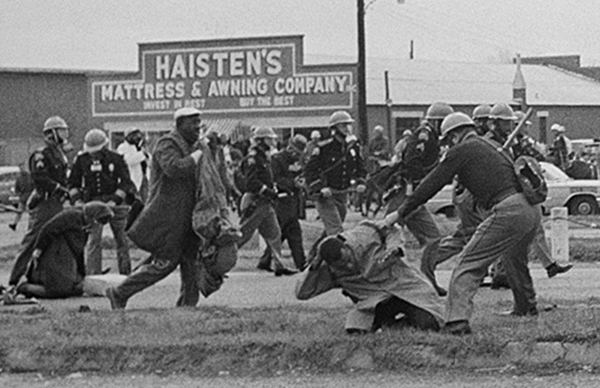
Selma, Alabama, March, 7, 1965: A demonstration for voter rights was viciously attacked by cops on what is known as “Bloody Sunday.” (Photo: AP)
Case #11 (Part 1): Violent Suppression of Black People’s Right to Vote
During the short period of Reconstruction, Black people in the South, along with some whites, fought heroically for their constitutional right to vote. About 1,500 Black men were elected to various state and local offices across the country. For the first time, Black people sat in the U.S. Congress.
This was bitterly opposed from the beginning, through the Civil Rights era, and right up to today.
THE CRIMES: New Orleans, July 1866: Mob attack on Black and some white delegates to Louisiana Constitutional Convention; Eutaw, Alabama, October 1870: Klan terror as elections for governor approached; McComb,Mississippi, 1961: Klan assault on SNCC workers; Neshoba County, Mississippi, 1965: Murders of James Chaney, Michael Schwerner, and Andrew Goodman during Freedom Summer voter registration campaign...and more. Read more
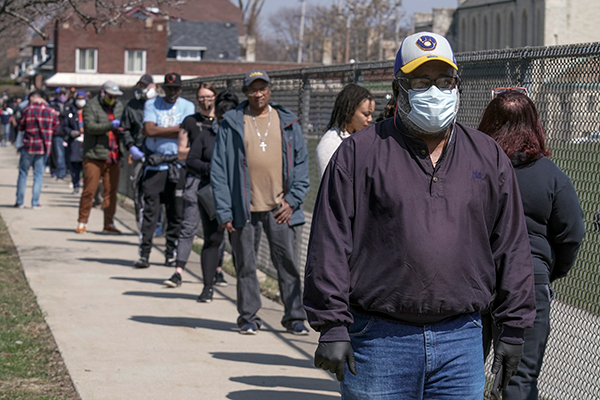
The supreme court of Wisconsin ruled against delaying an election there, even as the virus raged in Milwaukee – thousands of people wanting to vote were forced to wait in long lines, since only five polling places were open. (Photo: AP)
Case #11 (Part 2): 1965 to Today: Gutting the Voting Rights Act and Disenfranchising Millions of Black People
THE CRIMES:The Voting Rights Act (VRA) was signed into law in 1965, as the civil rights movement crested. It was designed to enforce the 15th Amendment to the U.S. Constitution, which reads, “The right of citizens of the United States to vote shall not be denied or abridged by the United States or by any State on account of race, color, or previous condition of servitude.”
Efforts to undermine the VRA began almost immediately after it was enacted, and accelerated after Barack Obama was elected president... Today Republicans are funneling tens of millions of dollars into escalating what the New York Times called “a focus on limiting who can vote that became a juggernaut after the Supreme Court dismantled the Voting Rights Act in 2013.” Various fascist organizations are initiating lawsuits, recruiting “poll monitors” to intimidate voters, and launching their own “anti-fraud” campaigns. Spearheading this effort is the well-funded “Honest Elections Project,” formed by a staunch Trump ally. A prominent member of the Conservative Political Action Committee said that as November approaches, “It’s going to be all hands on deck.” Read more
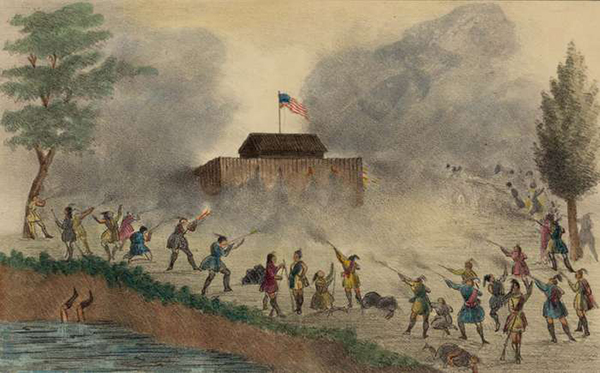
Case #10: The Blood-Soaked Statehood of Florida, the Expansion of Slavery, and Genocidal Andrew Jackson
Florida became the 27th state in 1845, and in recent years has played a prominent part in U.S. politics. Many school children learn the dates different states entered the union, but have no idea of the history that led up to statehood. In Florida’s case, it involved numerous invasions of Spanish territory, the bloody ending of Florida as a refuge for escaped Black slaves and indigenous people, and the genocidal conquest of the Seminole nation, all serving as a major driver in the expansion of slavery in Florida, and overall. Andrew Jackson, as military general and then U.S. president, played a key role in carrying out all of these crimes. Read more
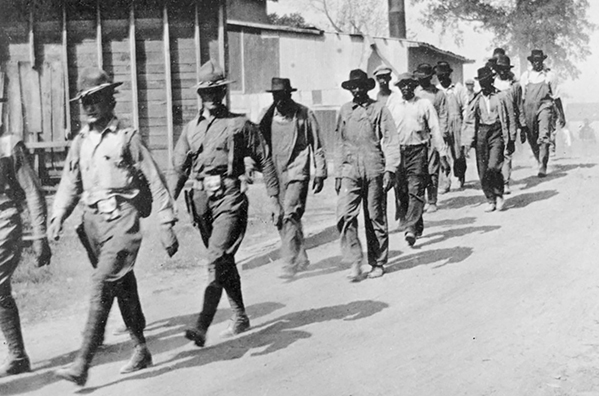
Case #9: The 1919 Massacre of Black Sharecroppers in Elaine, Arkansas
THE CRIME: On the night of September 30, 1919, 100 or so Black sharecroppers crowded into a small church in Phillips County, Arkansas, three miles outside the town of Elaine. They were meeting with a white attorney from Little Rock to explore legal means of preventing white plantation owners from forcing them to sell their crops to the owners at below-market rates and to buy food and other supplies at price-gouging plantation-run stores, creating a cycle of constant debt. But this meeting soon became the flash point for one of the bloodiest massacres of Black people in U.S. history. Read more
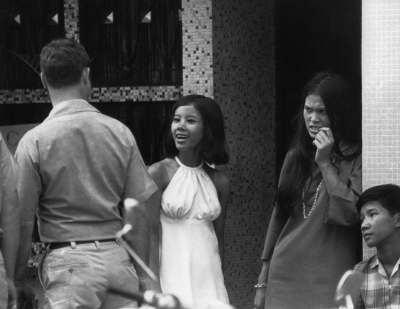
Women at a bar and passing U.S. soldiers in Saigon, May 28, 1971. Photo: AP
Case #8: America’s War in Vietnam and the Sexual Subjugation of Women
THE CRIME: America’s genocidal war in Vietnam during the 1960s and 1970s resulted in at least two to three million Vietnamese deaths and possibly as many as four million. As one little known but horrific part of this towering crime against humanity, the U.S. military participated in the creation of a huge “brothel economy” in Vietnam, Thailand and the Philippines. Rather than liberating the Vietnamese, they were subjugating an estimated half a million women to sexual domination by the U.S. Read more
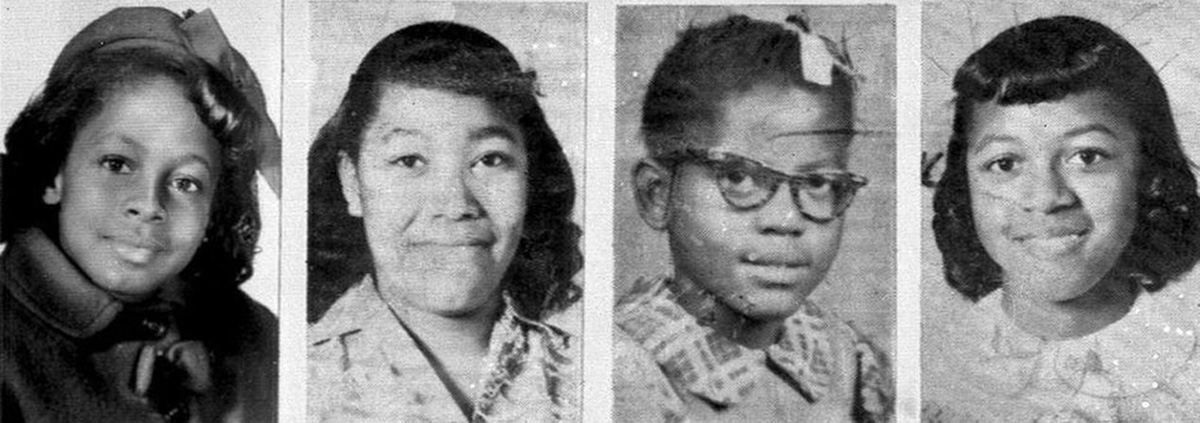
Four young girls who were killed when a bomb—set by the KKK— exploded before Sunday morning services at the 16th Street Baptist Church in Birmingham, Alabama, September 15, 1963. Denise McNair, Carole Robertson, Addie Mae Collins, and Cynthia Wesley.
Case #7: The 1963 Birmingham Church Bombing and the Cold-Blooded Murder of Four Black Girls
THE CRIME: On September 15, 1963, a bomb exploded before Sunday morning services at the 16th Street Baptist Church in Birmingham, Alabama. The bomb was set by local members of the Ku Klux Klan (KKK). Four young girls were killed and 20 others injured.
In the moments just before the murders, the girls chatted happily and straightened their fancy white dresses. It was Youth Day and excitement filled the air; they were going to take part in the Sunday adult service. Addie Mae Collins, 14, and Denise McNair, 11, were preparing to sing in the church choir. Carole Robertson and Cynthia Wesley—both 14—were going to be ushers. Addie Mae was helping Denise tie the sash on her dress. But before she could finish, the bomb went off. Minutes before 11 o’clock, the congregation was knocked to the ground. As the bomb exploded under the steps of the church, the worshippers sought safety under the pews and shielded each other from falling debris. In the basement the four girls were killed. Sarah Collins, Addie’s sister, survived, but lost an eye in the bombing. Read more
Click here for more:
Republicans, Democrats and U.S. Crimes Against Humanity: A Chart
The Republican Party Is Fascist
The Democratic Party Is Also a Machine of Massive War Crimes and Crimes Against Humanity
This System CANNOT Be Reformed—It MUST Be Overthrown!
Call for Volunteers: Research or write for the revcom.us series: American Crime
Volunteers Needed... for revcom.us and Revolution
If you like this article, subscribe, donate to and sustain Revolution newspaper.


